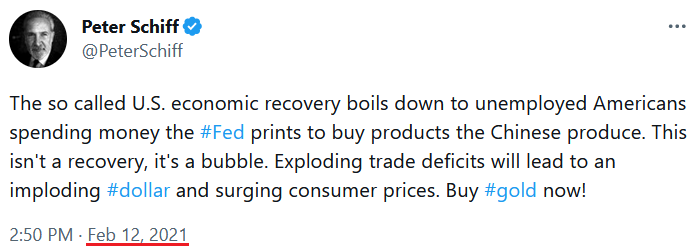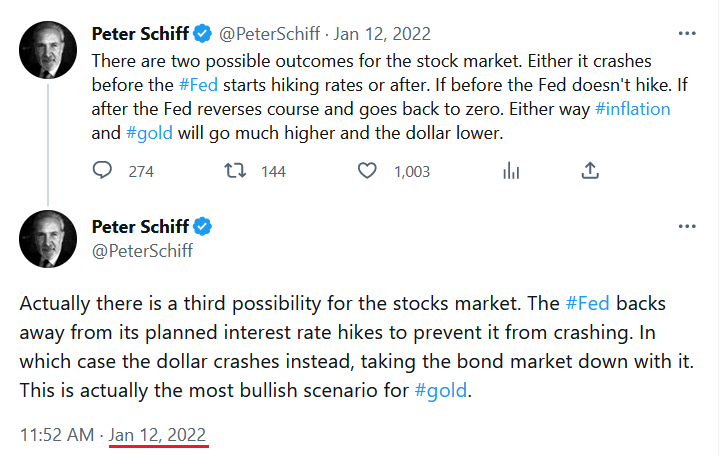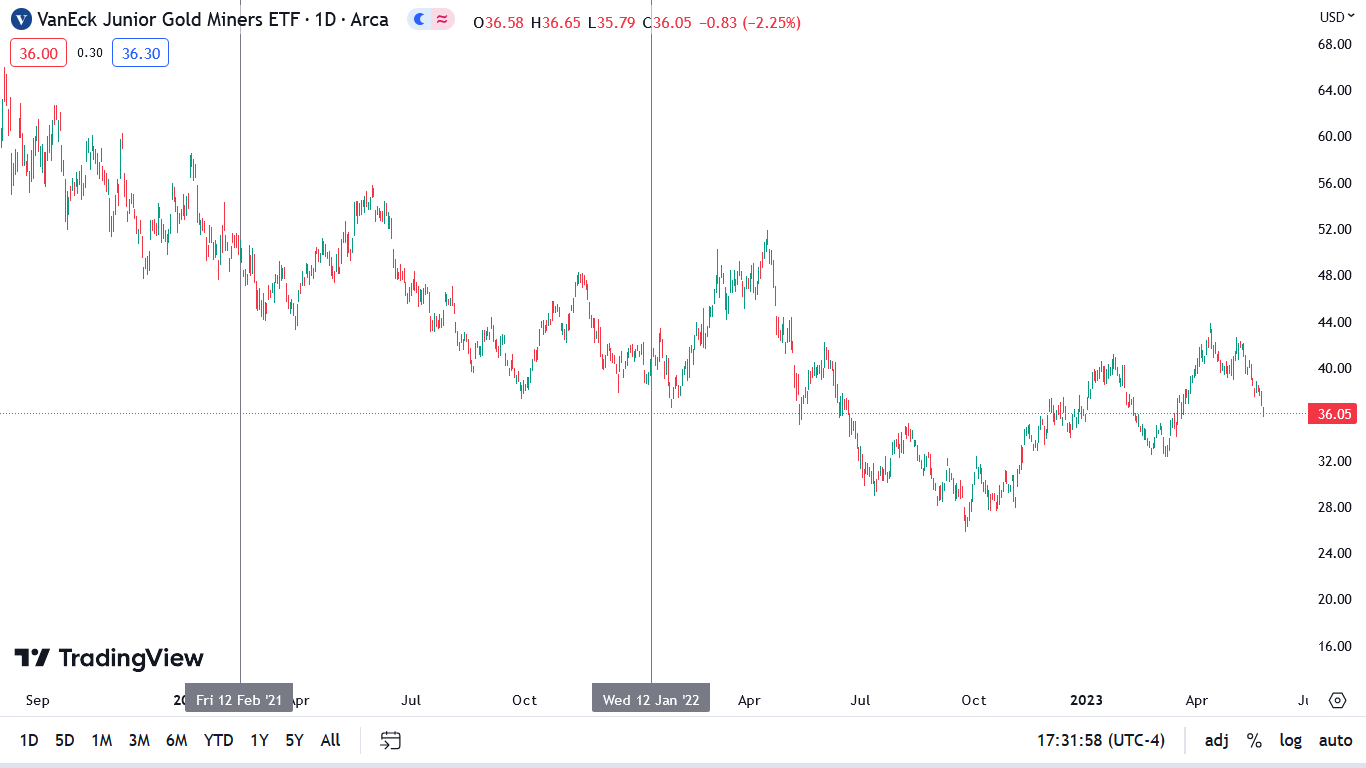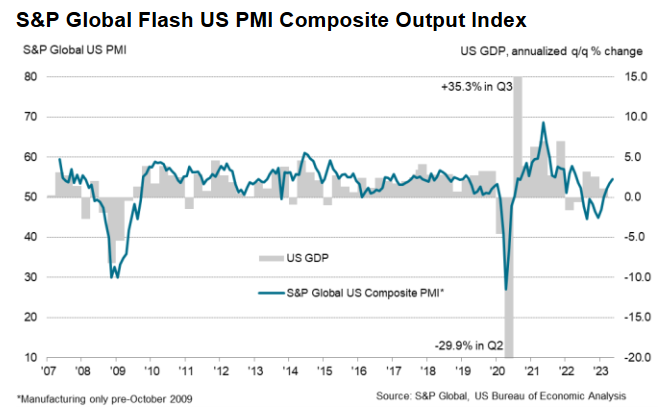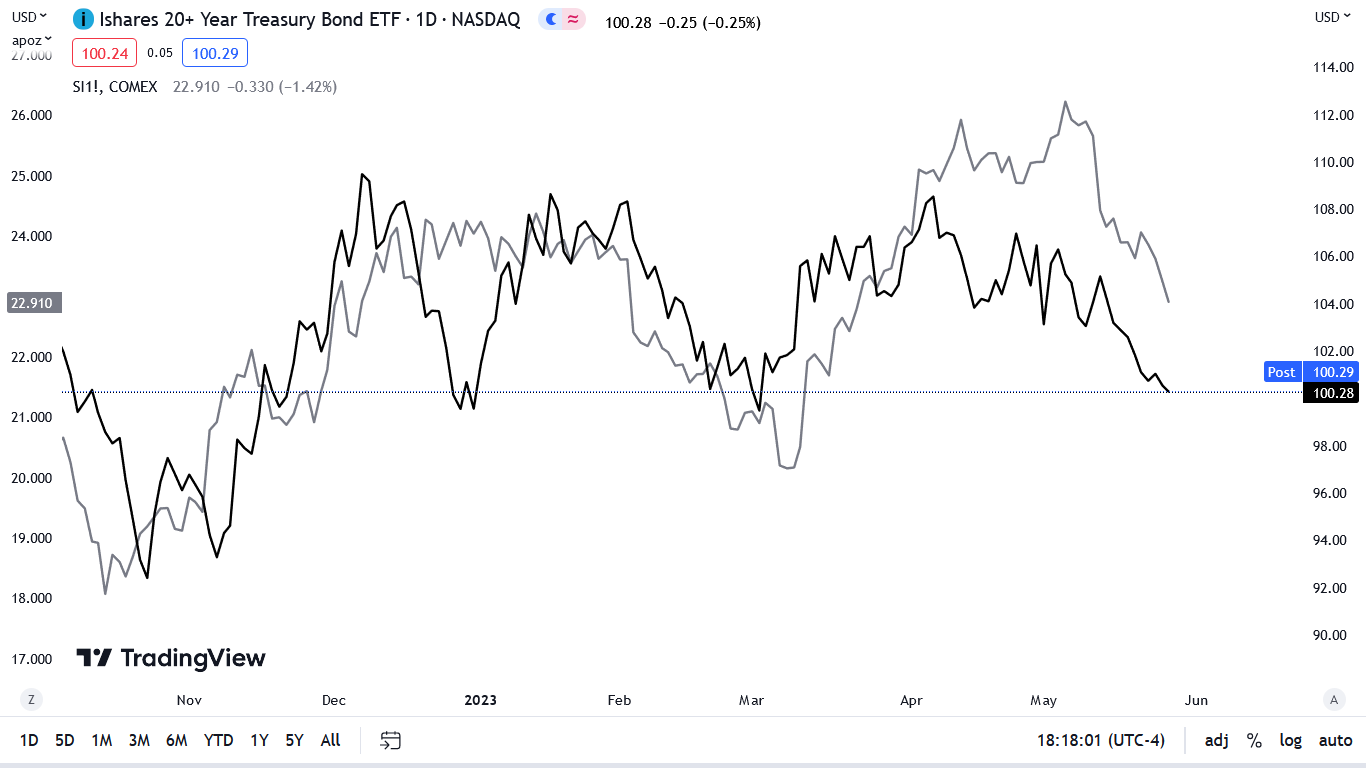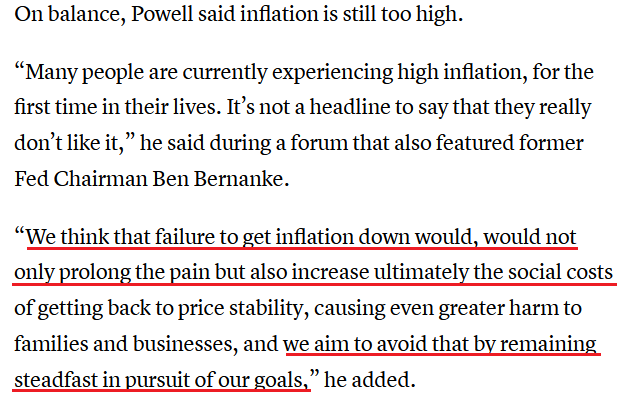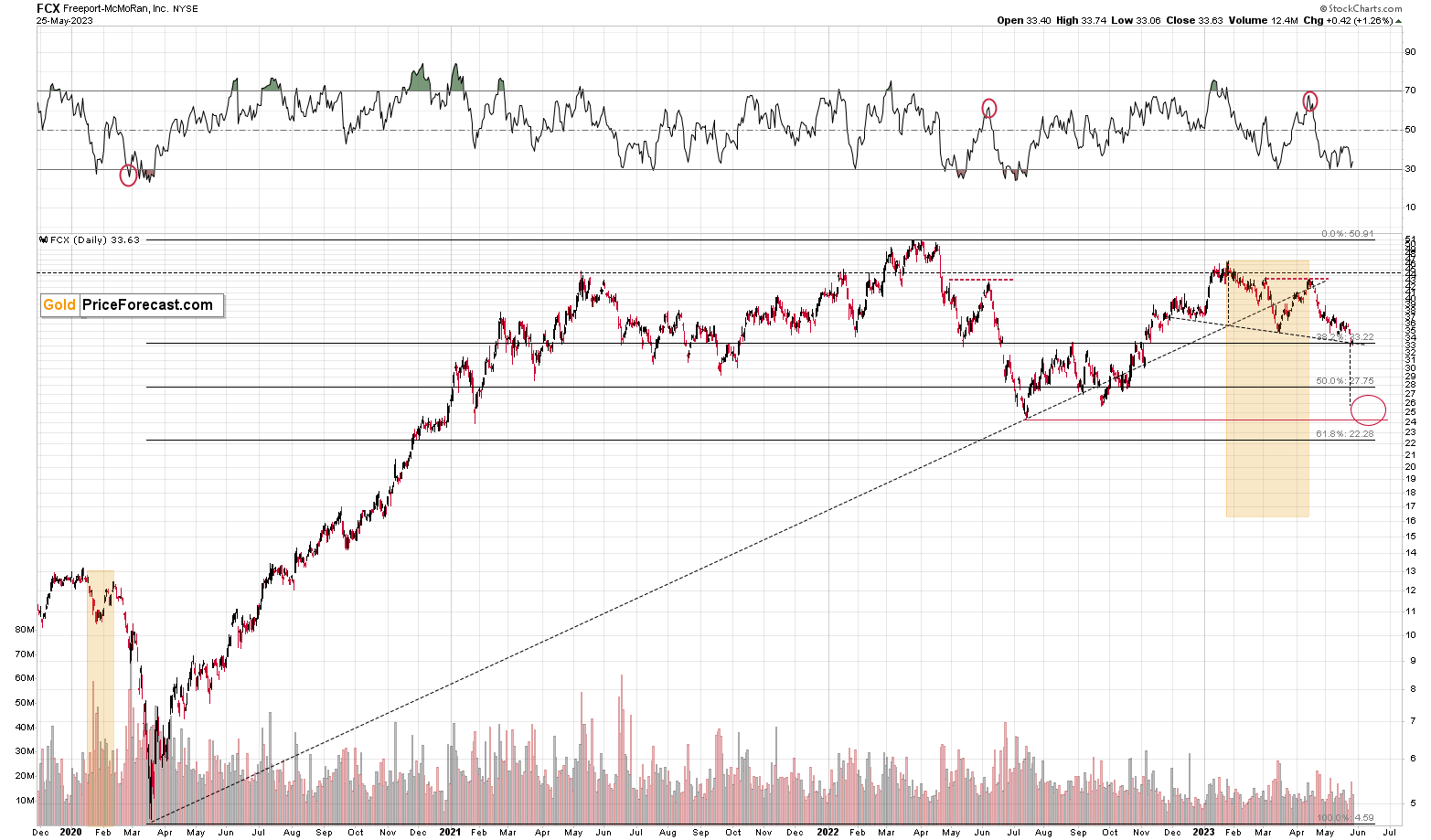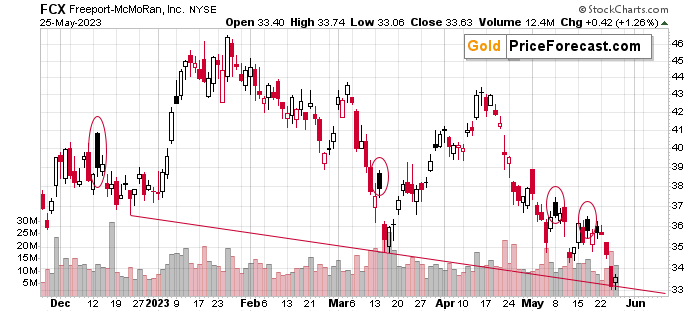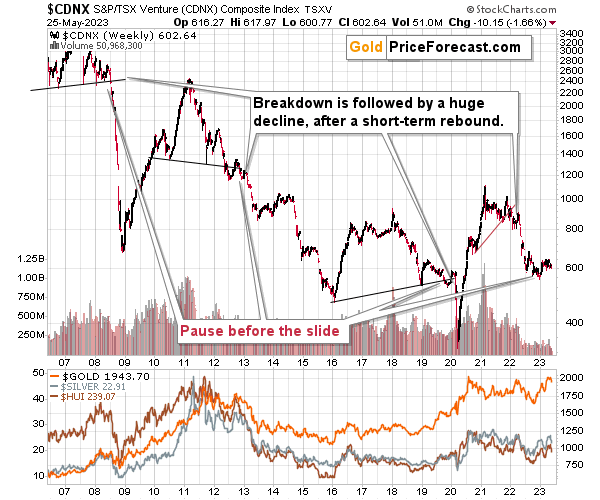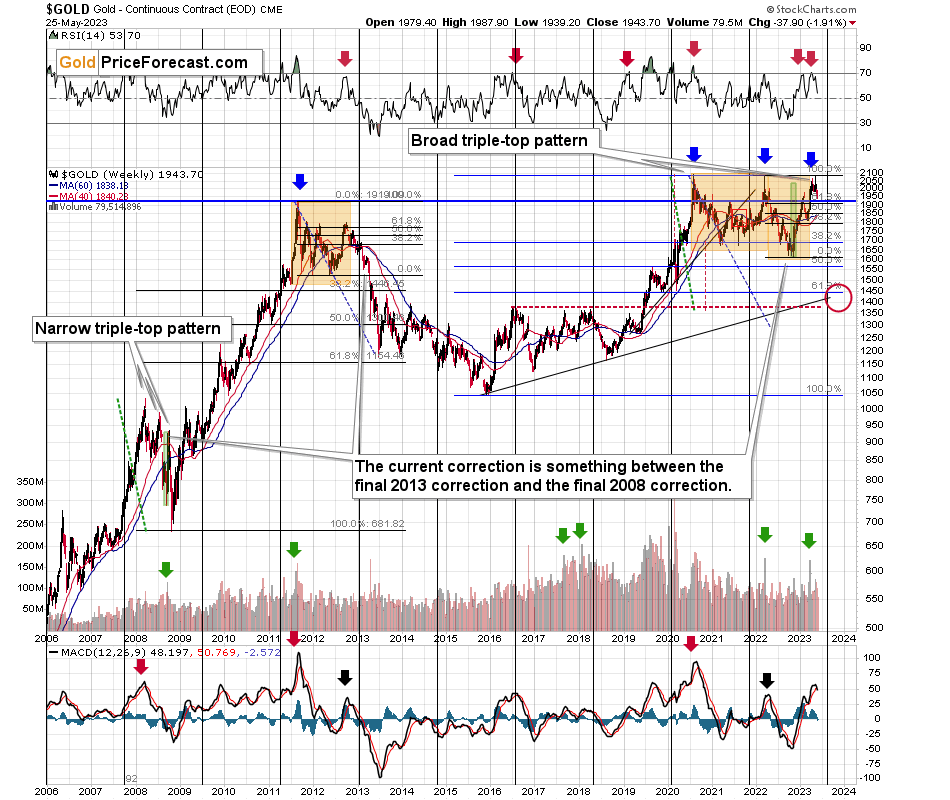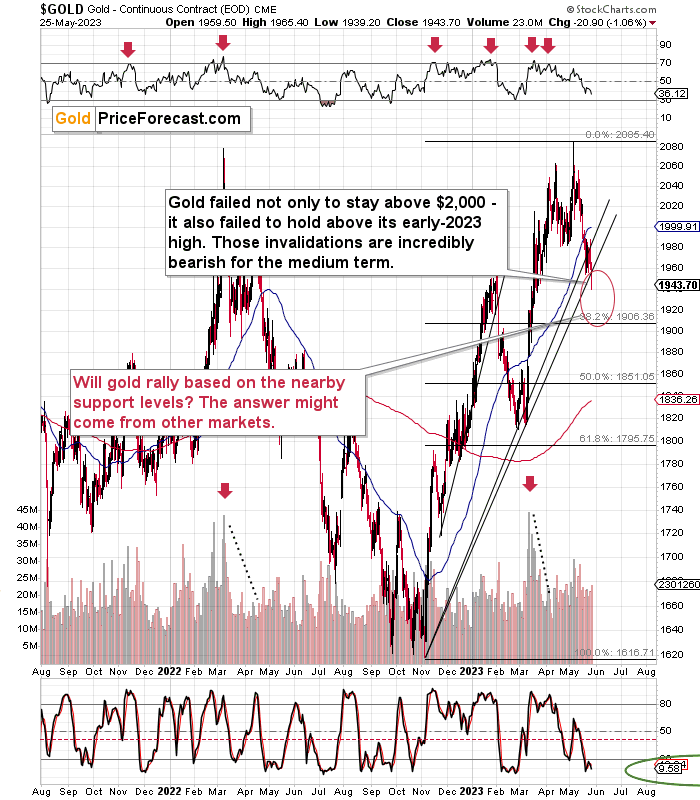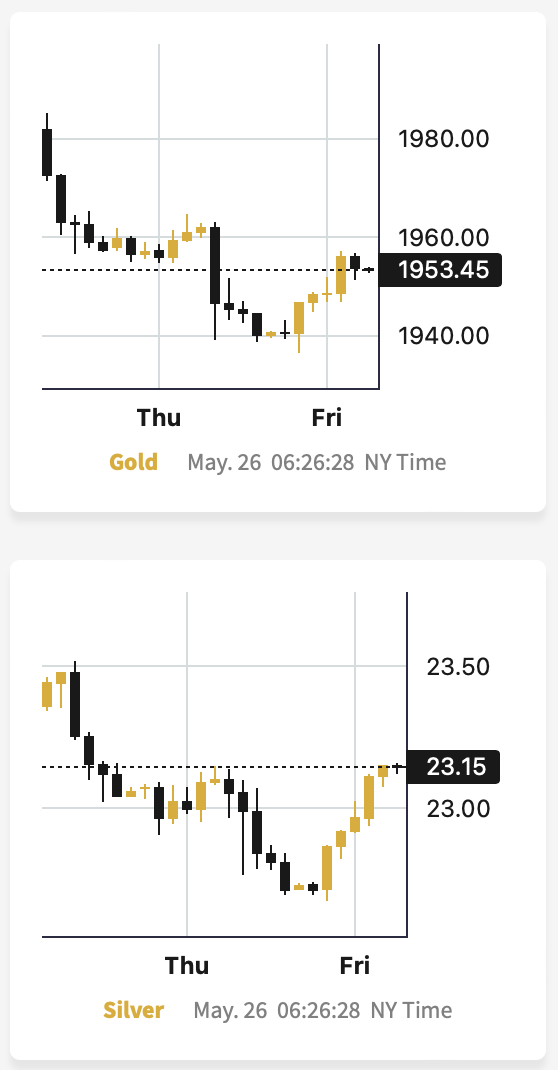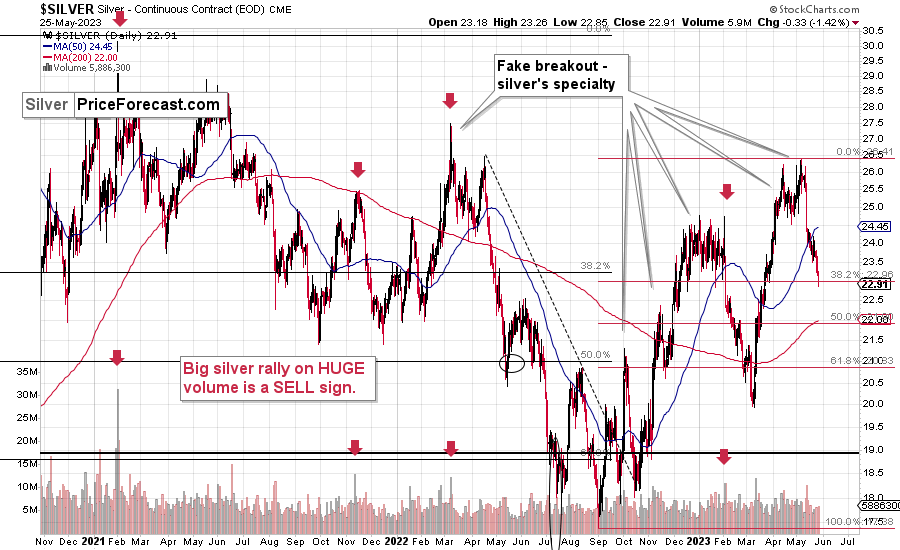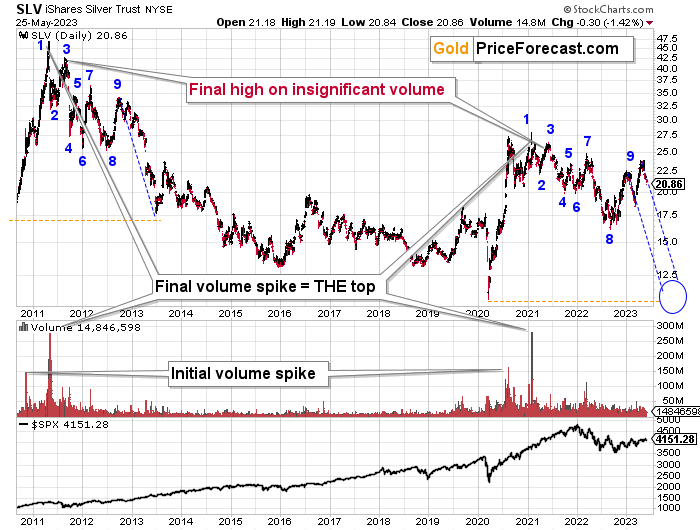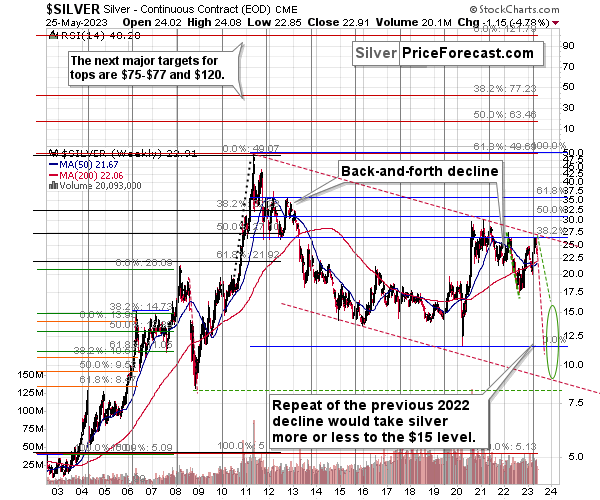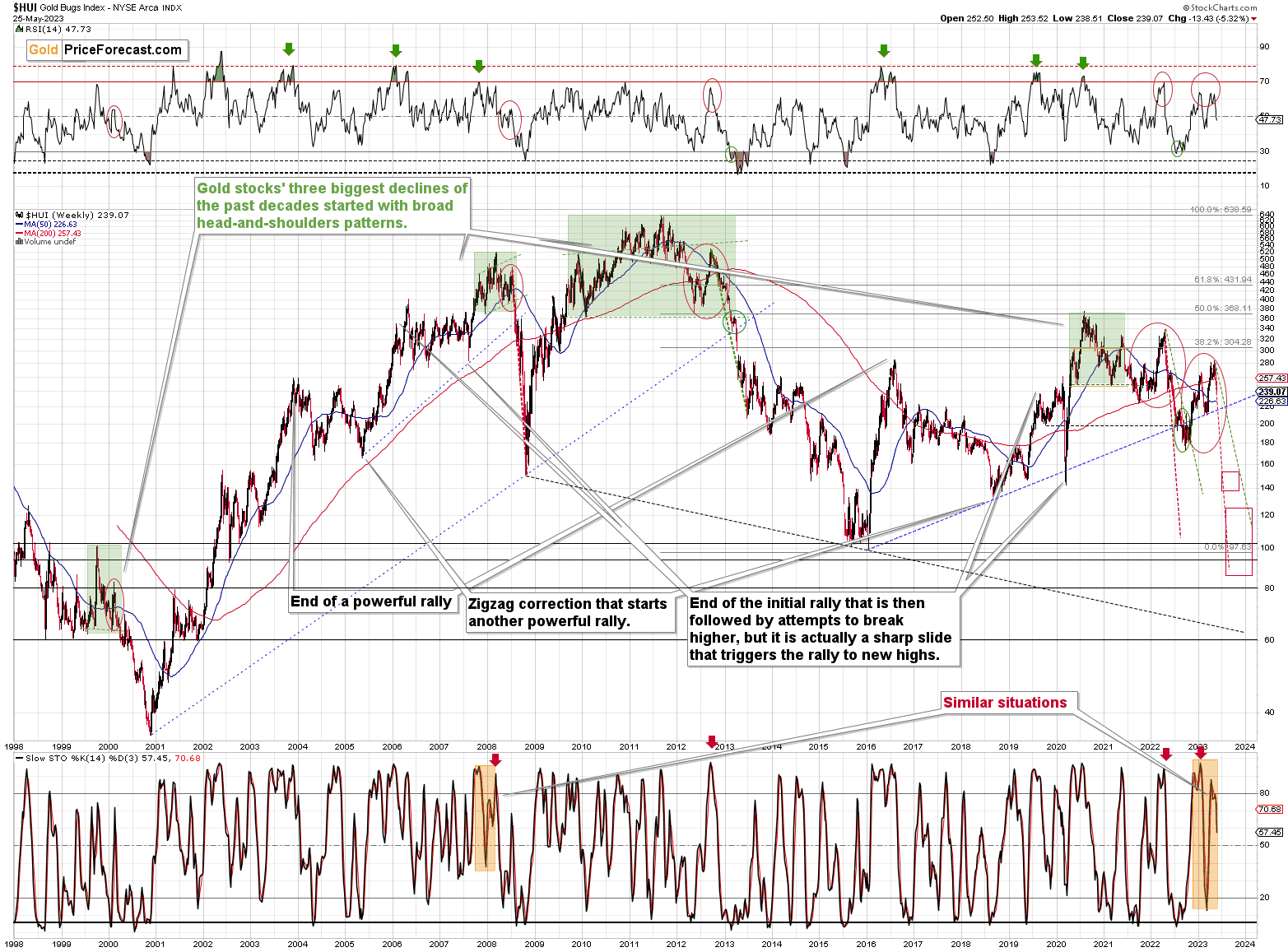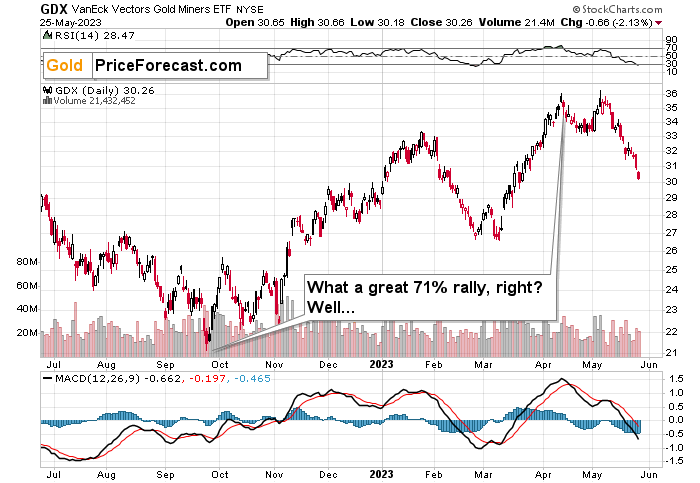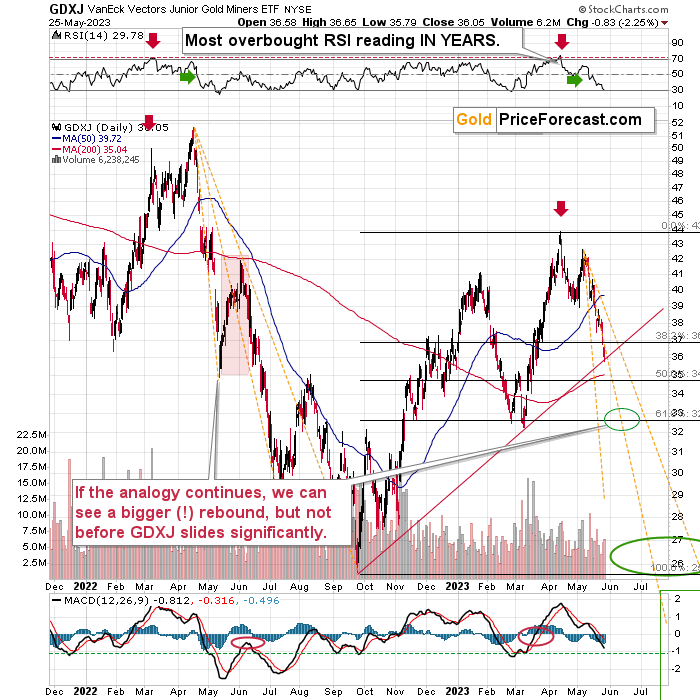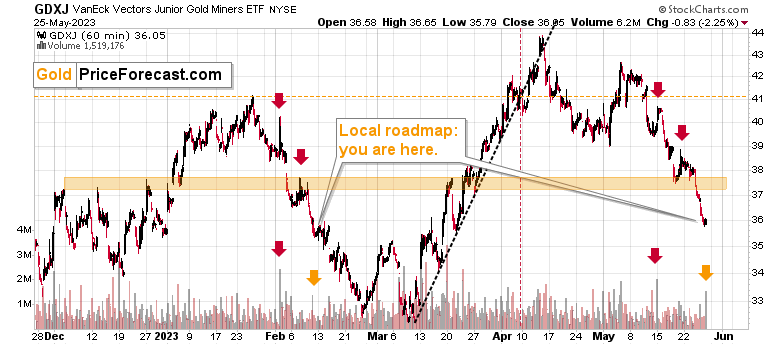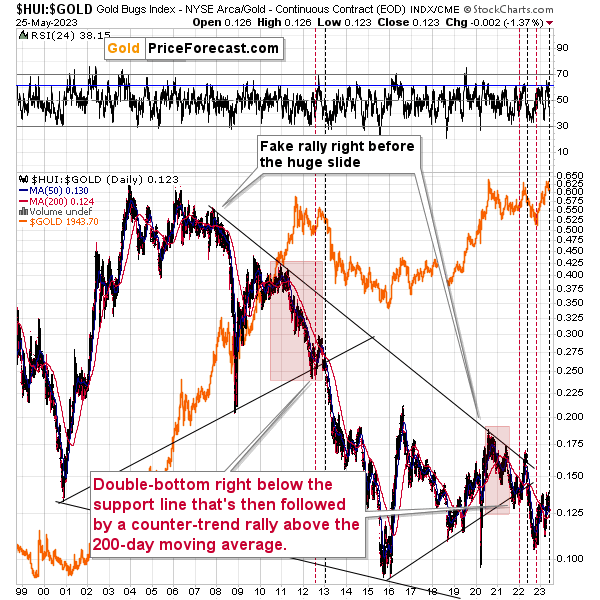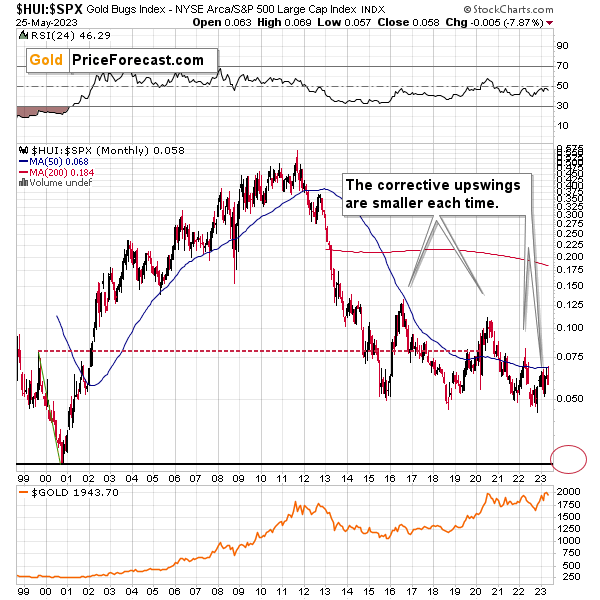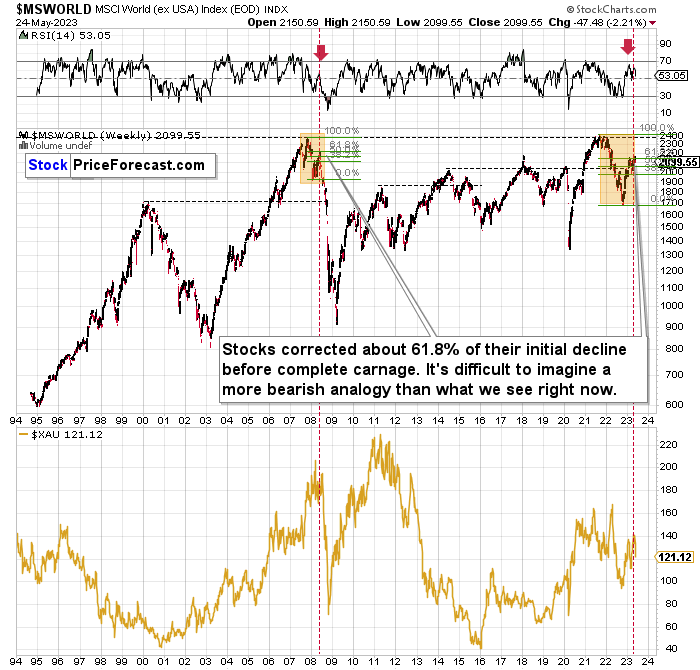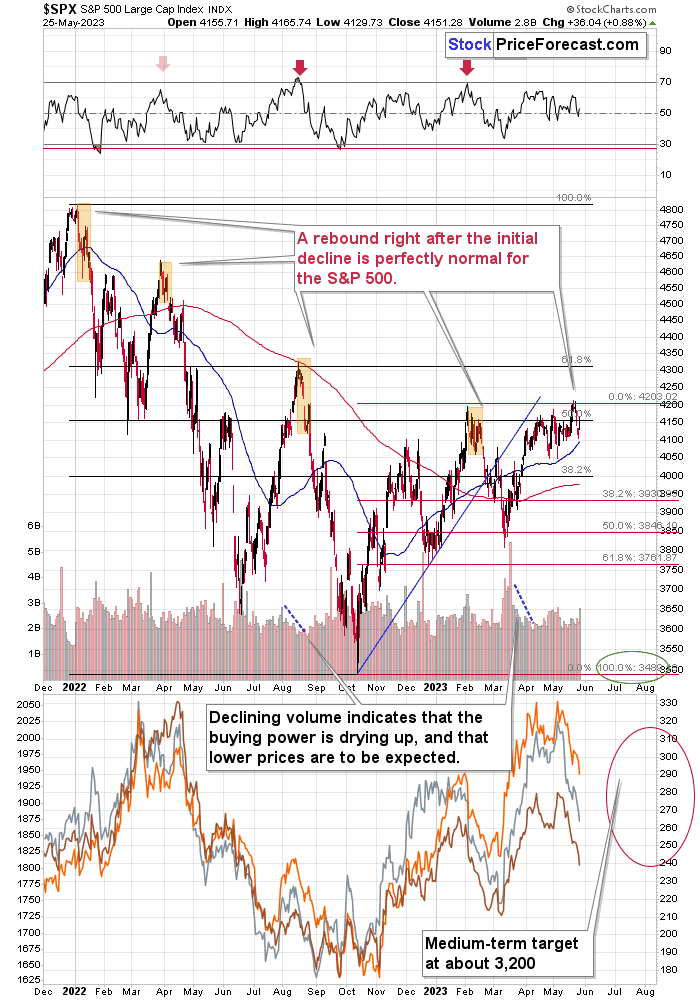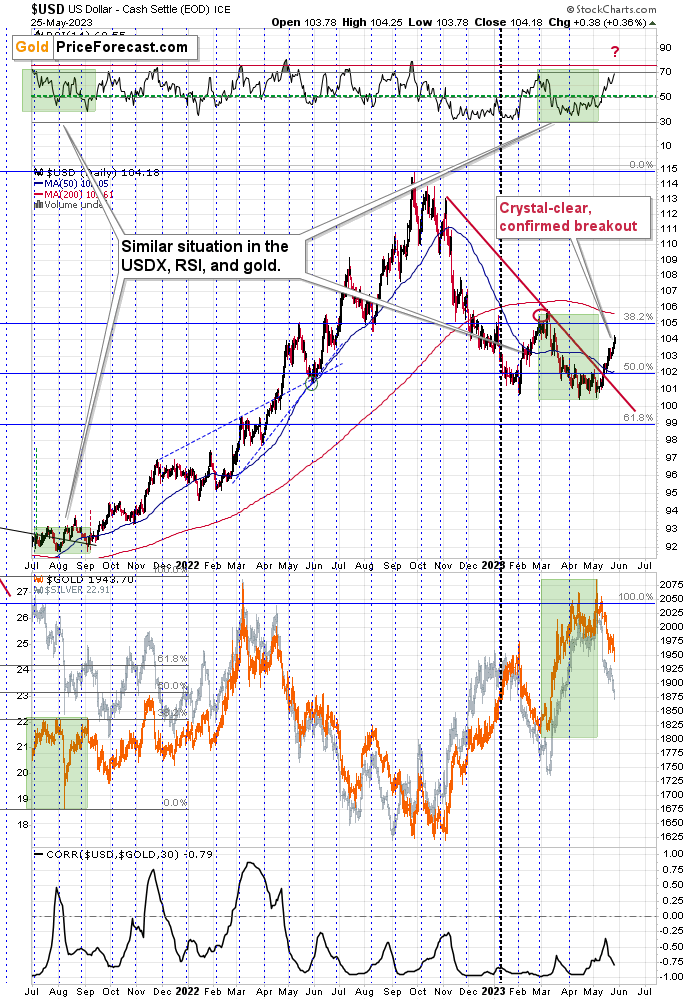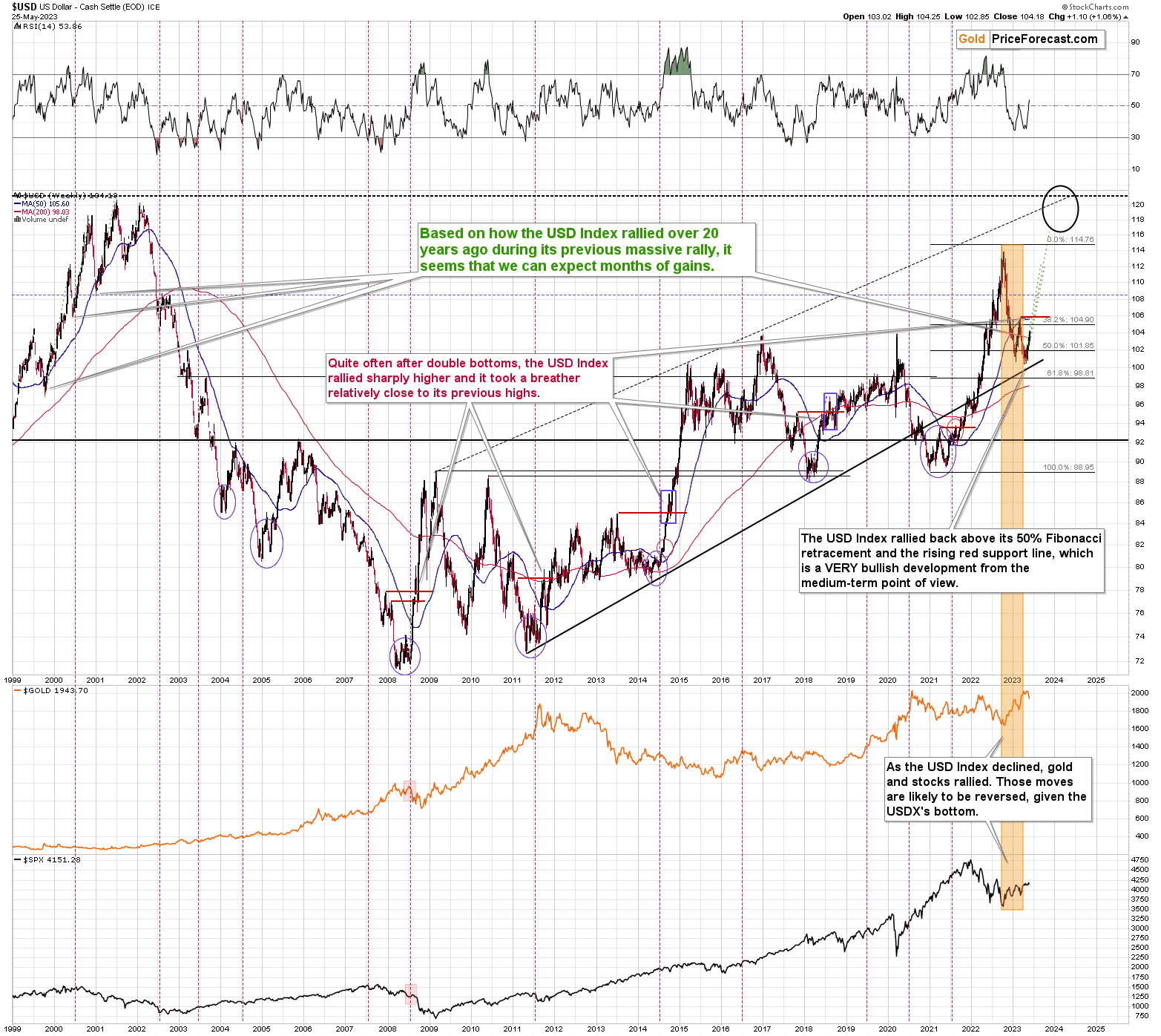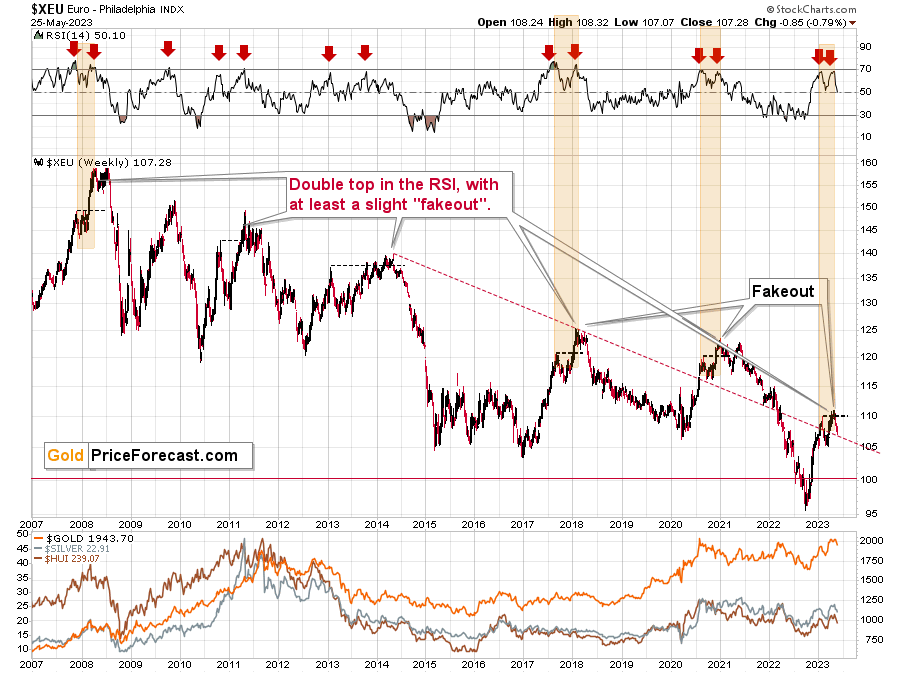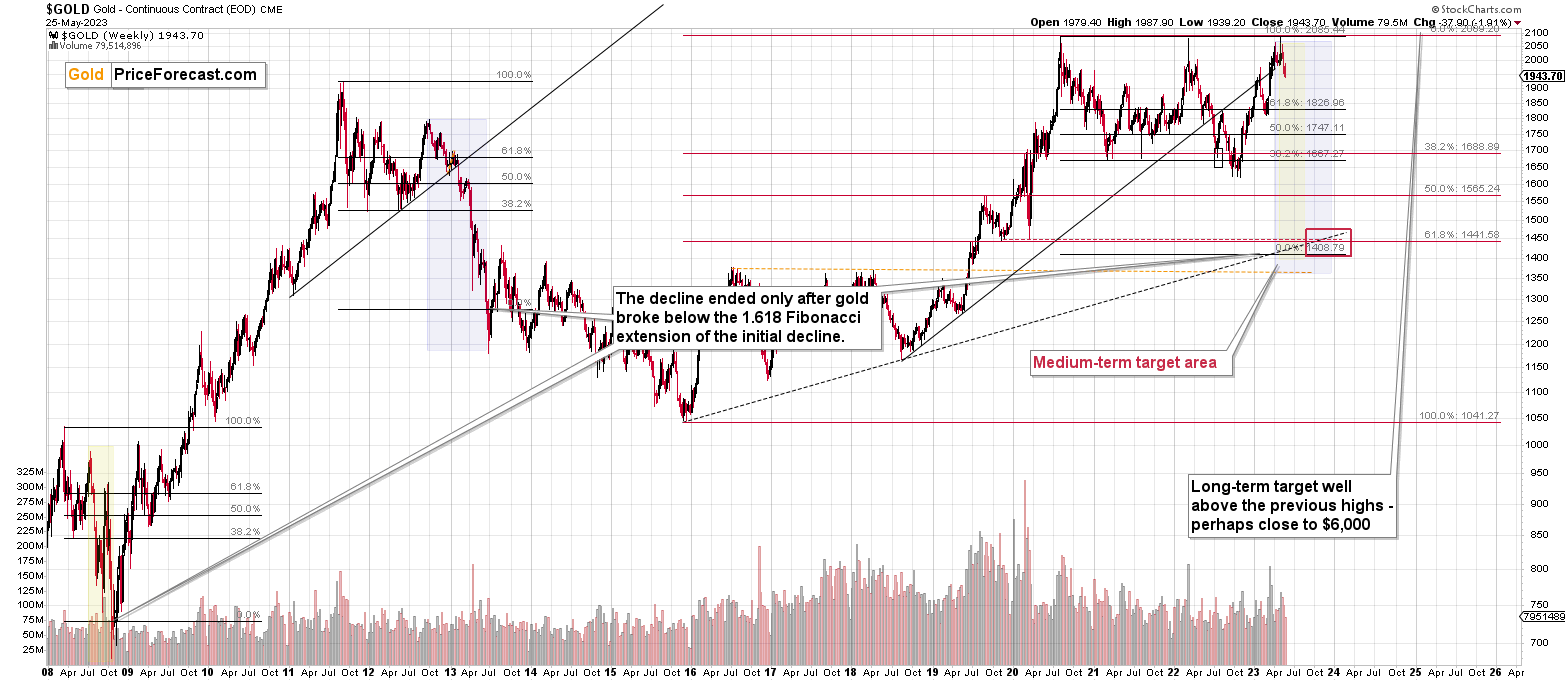Briefly: in our opinion, full (300% of the regular position size) speculative short positions in junior mining stocks are justified from the risk/reward point of view at the moment of publishing this Alert.
Welcome to this week's flagship Gold Trading Alert.
Predicated on last week’s price moves, our most recently featured medium-term outlook remains the same as the price moves align with our expectations. On that account, there are parts of the previous analysis that didn’t change at all in the earlier days and are written in italics.
The key thing that’s most important from our point of view that happened this week is that we saw another big (almost $40 so far) slide in gold and a massive slide in mining stocks, which moved lower by almost 6%. Moreover, we just took huge profits from the position in the FCX that we had opened in early April when it was still trading close to $40 (we now closed it close to $33).
Quite many things happened on the fundamental front as well, so I’ll take this opportunity to update you on those changes first, and I’ll move to the technicals next.
The Weekly Fundamental Roundup
With reality returning to the financial markets, interest rates have reset materially higher. And with the USD Index following suit, the two-headed monster has helped upend gold, silver, and mining stocks.
Moreover, with resilient economic data hitting the wire this week, prophecies of an imminent recession have been debunked. And the longer an economic malaise is put on hold, the longer the Fed will stay hawkish and the more fundamental resistance the PMs will confront. As such, with inflation still troublesome, we expect more of the same over the medium term.
Is It Wise to Follow the Gold Bugs?
With the gold bugs repeating their mistakes from 2021 and 2022, they remain steadfast that debt levels are too high, the U.S. economy cannot withstand higher interest rates, and when the Fed restarts QE, gold, silver and mining stocks will soar.
In other words, they follow the mantra, “the Fed is trapped,” which means no matter what officials do, they will fail. If they raise interest rates, debt becomes unaffordable, and the U.S. economy crashes. If they don’t, inflation runs rampant, and a crisis erupts.
Yet, 2021 and 2022 proved these theories were much more semblance than substance. And while some parts could prove accurate over the long term – because history shows 85% to 90% of the time, inflation rises substantially, recessions follow, and the Fed cuts interest rates – you need immense patience to wait for this outcome.
For example, please see what famous gold bug Peter Schiff wrote on Feb. 12, 2021:
Moreover, he wrote on Jan. 12, 2022:
Now, the unfortunate reality is that the U.S. dollar did not crash, the Fed did not reverse course and cut the U.S. federal funds rate (FFR) to zero, and gold’s performance has been mixed throughout that period. However, please remember that we’re concerned with the GDXJ ETF’s performance. Therefore, while gold has demonstrated relative strength, using Schiff’s thesis to trade the junior miners’ index has been a losing proposition.
Please see below:
To explain, the candlesticks above track the GDXJ ETF’s price. And if you analyze the vertical gray lines, you can see that the junior miners’ index ended the Feb. 12, 2021, session at $50.25 and the Jan. 12, 2022, session at $41.61. As a result, after closing at $36.05 on May 25, you would be down by 28% and 13%, respectively, if you held like a gold bug.
So, the main point is that a collapsing U.S. economy and an insolvent U.S. Treasury may combine for an interesting story, but it does not reflect fundamental reality. Conversely, the U.S. unemployment rate is at a 50+-year low, and the Fed has no reason to pivot when inflation is unstably high and the labor market remains resilient. If the unemployment rate rose to 5% or 6%, then an argument could be made. Yet, right now, it’s an easy decision for the Fed to prioritize fighting inflation.
On top of that, we warned on numerous occasions that the Fed has always pushed the FFR above the peak year-over-year (YoY) core Consumer Price Index (CPI). And with the latter peaking near 7% in this cycle, history is not on the pivot bulls’ side.
You Can’t Run from Reality
While the recession crowd opined that the recent bank runs would crash the U.S. economy, the economic impact proved minimal. Then, when tightening credit standards became the latest doom narrative, it breathed new life into the pivot bulls and helped uplift the PMs. But, we warned on Apr. 6 that the thesis was built on a faulty foundation. We wrote:
To explain, the red line above tracks the USD Index, while the green line above tracks the U.S. 10-Year Treasury yield. More importantly, the black line above tracks the inverted (down means up) December 2023 Eurodollar futures contract.
For context, Eurodollar is a proxy for the expected FFR. And since the yield moves inversely to the price, when Eurodollar rises, it means the crowd is pricing in a lower FFR.
Now, if you analyze the relationship, you can see that perceptions of a more hawkish Fed (higher black line) helped uplift the USD Index and the U.S. 10-Year Treasury yield. Conversely, the vertical gray line on the right side shows how the recent banking crisis has the crowd pricing in rate cuts by the end of December (lower black line), which has weighed on the USD Index and the U.S. 10-Year Treasury yield.
However, rate cuts are wishful thinking without a full-blown banking crisis, and a reversal of these expectations should rock the PMs in the months ahead.
To that point, with hawkish expectations rising dramatically recently, it’s no surprise the PMs have come under pressure.
Please see below:
To explain, the black, red and green lines above show how December rate-hike expectations, the USD Index and the U.S. 10-Year Treasury yield have erased roughly two-thirds of their bank-run moves, and their hawkish resets are profoundly bearish for gold, silver and mining stocks. For context, Eurodollar has been discontinued, and SOFR is the prominent FFR proxy.
Therefore, the fundamental thesis continues to play out as expected, and the crowd still underestimates the challenges of reining in inflation.
Speaking of which, S&P Global released its U.S. Composite PMI on May 23. The headline index increased from 53.4 in April to 54.5 in May, hitting a 13-month high. The report stated:
“Companies in the U.S. registered a solid upturn in business activity during May, according to the latest ‘flash’ PMI data from S&P Global. Overall growth in output was the fastest for just over a year. The expansion was led by service providers, however, as manufacturers recorded only a slight rise in production.”
In addition, the report added:
“Employment growth remained solid in May. Total private sector workforce numbers increased at the fastest pace since July 2022 as companies stated that a greater ability to hire and increased availability of candidates supported job creation.”
Thus, while we warned repeatedly that interest rates were too low to create the demand destruction necessary to tame inflation, S&P Global’s data continues to support that argument.
Overall, the gold bugs have a solid long-term argument that may play out in the years ahead. In contrast, we’re more concerned about the months ahead and have been consistent in our belief that resilient demand has only suffered a mild contraction. And until it becomes material, solid growth, employment and inflation should keep the pressure on the Fed.
Do you think “the Fed is trapped?”
What to Make Of Silver’s Sorry Performance
Despite the permalbulls oozing with overconfidence, we warned on May 5 that their discourteous behavior is often a precursor to a reversal. We wrote:
The crowd remains immensely confident, which is a positive sign, not a negative one. When the permabulls count their chickens before they hatch, we’re often near an inflection point. Consequently, we believe more pain will confront the PMs, as the risk-reward is heavily skewed to the downside.
Likewise, while the crowd thumbed their nose at the impact of higher long-term interest rates, the latter weighed on the white metal’s performance.
Please see below:
To explain, the gray line above tracks the silver futures price, while the black line above tracks the iShares 20+ Year Treasury Bond (TLT) ETF. If you analyze the relationship, you can see that higher TLT prices (lower long-term interest rates) have been celebrated by silver.
Conversely, the sharp declines on the right side of the chart show how TLT is approaching its 2023 lows and the white metal has not been fond of re-pricing. As a result, while many assumed a silver bull market was underway, long-term traction will be difficult until inflation, interest rates, and the U.S. dollar stabilize.
Fed Musings
While Fed Chairman Jerome Powell said on May 19 that the FFR “may not need to rise as much” if the economy weakens, he warned that “the extent of that is highly uncertain.” As such, this is similar to what he said in 2021 and 2022. If inflation fades gracefully, the Fed can relax. If not, interest rates will need to rise further to cool the U.S. economy.
Please see below:
Also, Minneapolis Fed President Neel Kashkari said on May 23:
“Right now it’s a close call either way, versus raising another time in June or skipping. Some of my colleagues have talked about skipping. Important to me is not signaling that we’re done. If we did skip in June, that does not mean we’re done with our tightening cycle.”
He added:
“Do we then start raising again in July? Potentially, and so that’s the most important thing to me is that we’re not taking it off the table.”
So, while the crowd wants this rate-hike cycle to end – just like they did in 2022 – you can’t wish it into reality. On the contrary, there is a lot of pivot hope that’s not supported by the fundamental data.
Please see below:
Furthermore, St. Louis Fed President James Bullard said on May 22:
“I think we’re going to have to grind higher with the policy rate in order to put enough downward pressure on inflation and to return inflation to target in a timely manner. I’m thinking two more moves this year – exactly where those would be this year I don’t know – but I’ve often advocated sooner rather than later.”
And Dallas Fed President Lorie Logan said on May 18:
“After raising the target range for the federal funds rate at each of the last 10 FOMC meetings, we have made some progress. The data in the coming weeks could yet show that it is appropriate to skip a meeting. As of today, though, we aren’t there yet.”
Consequently, while some Fed officials like Jefferson and Bostic preach various degrees of patience, the reality is that GDP growth has outperformed expectations, which we warned would happen. And as long as this is the case, it spells trouble for the PMs.
Finally, while Bank of America’s Chief Investment Strategist Michael Hartnett had predicted a Q1 recession, he changed his tune on May 19, writing that if the Fed “mistakenly” pauses rate hikes, long-term interest rates will rise, “and if so, we most certainly ain’t seen the last Fed rate hike of the cycle.”
As such, the “pain trade” is higher interest rates, not lower.
Overall, many of our fundamental predictions have come to fruition. You can’t solve sticky inflation with long-term interest rates near 3% to 3.5%. Moreover, we warned throughout 2021 and 2022 that U.S. households were flush with cash and that cushion has continued to spur resilient demand. As a result, while the crowd is desperate for material disinflation, only mild progress has occurred, and the base effects reducing the headline CPI are nearing an end.
Do you think the FFR will be closer to 6% or 3% at the end of 2023?
The Bottom Line
Dovish expectations have unwound, and the hawks are leading the charge. And while every basis point rise in interest rates elicits fears of an imminent recession, economic growth has remained resilient, and people still underestimate the imbalances created by the pandemic-induced stimulus. Therefore, we believe it’s unrealistic to expect inflation to die this easily, and as long as that’s the case, the liquidity drain should hurt the PMs.
In conclusion, the PMs declined on May 25 as interest rates and the U.S. dollar showcased their might. And with more of the same poised to materialize over the medium term, gold, silver, and mining stocks should confront more selling pressure before their bear markets end.
What to Watch for Next Week
With more U.S. economic data releases next week, the most important are as follows:
- May 30: Dallas Fed manufacturing index
While S&P Global’s nationwide data came in hot this week, the Dallas Fed’s regional survey will provide more color on how the employment, inflation and growth trends are evolving.
- May 31: Chicago PMI, Dallas Fed services index, JOLTS job openings
The Chicago and Dallas Fed reports will offer more regional insights into the state of the U.S. economy, while the JOLTS data provides a lagged look at employment prospects. And with Indeed’s weekly data declining slightly, JOLTS should remain relatively uplifted.
- Jun. 1: Challenger job cuts, ISM manufacturing PMI, ADP private payrolls
The job cuts data will highlight the layoff trends plaguing the U.S. labor market, while the ISM’s nationwide PMI will unmask the manufacturing outlook. For context, manufacturing has weakened relative to services, so it may mirror S&P Global’s results.
In addition, while ADP’s private payrolls don’t correlate well with U.S. nonfarm payrolls, the wage inflation insights are critical. As a result, it’s essential to monitor.
- Jun. 2: U.S. nonfarm payrolls, unemployment rate, labor force participation rate, average hourly earnings
Each month, the foursome moves the markets, as the results often lead to a re-pricing of rate-hike expectations. Thus, if employment growth remains abundant alongside resilient wage inflation, the hawkish implications could help the USD Index and hurt the PMs.
All in all, economic data releases impact the PMs because they impact monetary policy. Moreover, if we continue to see higher employment and inflation, the Fed should keep its foot on the hawkish accelerator. If that occurs, the outcome is profoundly bearish for the PMs.
Technically Speaking
Let’s start today’s technical discussion with a quick check of copper prices.
Copper rallied recently, but it stopped at its 61.8% Fibonacci retracement level and then moved back down. Consequently, the recent move – while impressive from the day-to-day point of view – remains to be a short-term correction only.
Consequently, what I wrote about it previously remains up-to-date:
Copper recently CLEARLY invalidated another attempt to move above its 2011 high. This is a very strong technical sign that copper (one of the most popular commodities) is heading lower in the medium term.
No market moves up or down in a straight line (well, the 2008 slide appears to have been an exception), and a short-term correction doesn’t necessarily invalidate the bigger trend. For the last couple of months, copper has been trading sideways, but it didn’t change much regarding the outlook.
In fact, it made my previous target area even more likely. You see, the consolidation patterns are often followed by a move that’s similar to the move that preceded them. In this case, the previous 2022 decline was quite significant, and if it is repeated, one can expect copper to decline well below 3.
Actually, copper could decline profoundly and bottom in the $2.0-2.7 area. That’s where we have rising, long-term support lines and also the previous – 2016 and 2020 – lows.
Flag patterns (which we just saw in copper) tend to be followed by price moves that are similar to ones that preceded them. I marked this on the above chart with red, dashed lines. This method supports a copper price’s move to around $2.7.
Given the size of the previous decline (and its pace), it seems quite likely that it could take another 2-7 months for copper to move to about $2.4. May seems to be the most likely time target given the current data.
Interest rates are going up, just like they did before the 2008 slide. What did copper do before the 2008 slide? It failed to break above the previous (2006) high, and it was the failure of the second attempt to break higher that triggered the powerful decline. What happened then? Gold declined, but silver and mining stocks truly plunged.
Again, copper is after invalidation of a major breakout, a decline, and a correction. Copper prices currently SCREAM that it’s a variation of 2008 all over again. This is extremely bearish for mining stocks (especially juniors) and silver.
On a very short-term basis, though, please note that copper encountered two support levels, and I marked both with black dashed lines. One is a rising support line based on two previous bottoms, and the other one is the previous low. This could trigger a corrective rally, especially since we (almost certainly) going to get the “hey, the debt ceiling was increased after all” relief rally. But that is likely to be just a short-term phenomenon, after which copper’s downtrend is likely to be resumed.
Before moving further, I’d like to extend the copper analysis into the analysis of the situation in one of the major copper companies – FCX.
We just profitably closed a short position in it, but I’m featuring this chart to show you that the bearish potential that this asset has is still there (so, we’ll probably profit from another decline in it in the following weeks/months). This bearish potential is huge.
The FCX moved back above its rising support line, and it invalidated this move and then in plunged.
The decisive move lower, despite lack in the S&P 500 shows weakness in the FCX and indicates further declines ahead.
Technically, the recent situation seems similar to what we saw in June, 2022. Back then the FCX topped with RSI at similar levels and with price itself close to its recent high.
The decline that we saw back then was much bigger than what we’ve seen so far recently. This means that the odds are that the decline is going to continue.
On a very short-term basis, however, the FCX might correct as it touched its declining support line without breaking below it.
This line might become the neck level of a head and shoulders top pattern that then facilitates bigger declines, but for now, it serves as support. And given that the markets are likely to be positively surprised by the fact that the U.S. doesn’t default on its debt, they could rally.
Not necessarily the precious metals sector, though, because the above would imply less demand for gold from the safe-haven point of view.
Also, since FCX’s performance is connected to the one of the stock market, you’ll see more bearish (medium-term) indications in the following part of the analysis.
Long story short – the big profits on the FCX are likely to become even bigger in the future.
Having said that, let’s check the junior miners’ really big picture.
In short, we saw a tiny correction in the TSX Venture index, and this should be a major red flag for anyone thinking that the recent rally was a game- or trend-changer. This is a blip on the radar screen, similar to what we saw in the second half of 2021, before another big move lower.
The really important thing here is that we saw the first crack in the dam. The index declined visibly, and it might mean that the final part of the 2008-style slide has just begun.
Consequently, my previous comments on the above chart remain up-to-date:
The Toronto Stock Exchange Venture Index includes multiple junior mining stocks. It also includes other companies, but juniors are a large part of it, and they truly plunged in 2008.
In fact, they plunged in a major way after breaking below their medium-term support lines and after an initial corrective upswing. Guess what – this index is after a major medium-term breakdown and a short-term corrective upswing. It’s likely ready to fall – and to fall hard.
So, what’s likely to happen? We’re about to see a huge slide, even if we don’t see it within the next few days.
Just like it was the case in 2008, the move higher that we saw before the final (biggest) slide in gold, silver, and gold stocks (lower part of the chart), didn’t translate into a visible rally in the TSX Venture Index. Just as the index paused back then, it pauses right now.
Currently, it’s trading at about 600, and back then, it consolidated at about 2500. The price levels are different, but the overall shape of the price moves (lack thereof) is similar. This serves as a signal that the recent upswing in the PMs is not to be trusted.
The above chart is one of the weakest (from a technical point of view) that is seen across the board right now. There is a strong long-term downtrend visible in the TSX Venture Index, and if stocks slide similarly as they did in 2008, the TSXV could truly plunge – perhaps even to the 300 level or lower.
The important short-term detail is that the TSXV just broke to new yearly lows. This is a major (yet barely noticed by most) indication that the next big move lower is about to start.
Having said that, let’s turn to gold.
Let’s start with context:
Between 2020 and now, quite a lot happened, quite a lot of money was printed, and we saw a war breaking out in Europe. Yet gold failed to rally to new highs.
In fact, gold was just trading well below its 2011 high, which tells you a lot about the strength of this market. It’s almost absent.
There’s a war in Europe, and billions of dollars were printed, and gold was below its 2011 highs – in nominal terms! Adjusted for inflation, it’s much lower. And silver and gold stocks’ performance compared to their 2011 highs? Come on…
Truth be told, what we see in gold is quite in tune with what we saw after the 2011 top, and in particular, shortly after the 2012 top. We can also spot similarities between now and 2008. The long-term gold price chart below provides details.
Based on the most recent rally in gold, the price now seems quite similar to what we saw in 2008. This time, we see a triple-top pattern where the tops are far apart, whereas in 2008, they were relatively close to each other.
The link to 2011-2013 is still present, although in this case, the price moves to the upside are more visible.
To be more precise, I should say that those moves higher “were” visible, as based on yesterday’s closing price, gold is down by over $50 so far this month. And it’s most likely just the beginning of the big move lower.
The RSI above 70 shows how extremely overbought gold just was and how likely it is to slide in the following weeks and months. I marked also other similar cases with red arrows, and as you can see, they were indeed followed by declines.
Please note that gold’s attempt to move to new all-time highs and the failure thereof are strongly pointing to lower prices ahead. The emotionality that I described in my recent Gold Trading Alerts had probably burnt itself out as gold approached the previous highs. And now, it’s time for logic and cold calculations to take its place. The reality is that real interest rates are going higher, and that’s very bearish for gold prices.
Finally, I marked the big increases in weekly volume levels during gold’s upswings with green arrows.
The most recent case is from 2022, when gold topped.
The same happened in early 2018.
That’s how gold topped in 2011.
And – most importantly – that’s exactly what we saw at the final pre-slide top in 2008.
Please note that the rapid rally that we saw in 2008 before the slide was very much in tune with what we saw recently (note: green rectangles). Consequently, it’s not a bullish game-changer.
Gold recently moved above $2,000, and just as all previous attempts to move above this level failed, we’re likely to see it fail once again.
Let’s take a look at how the situation developed on the technical front back in 2008.
Gold’s final pre-slide corrective upswing was based on turmoil, uncertainty, and safe-haven buying. It was volatile, it was large, and it was accompanied by huge volume.
The RSI indicator moved a bit below the 70 level.
Sounds familiar?
Back in September and October, 2008, gold even rallied above its 61.8% Fibonacci retracement level.
During that time, the USD Index declined in a relatively sharp manner, and the GDX ETF pretty much followed the stock market.
It’s exactly the same thing right now (except for the fact that gold moved even higher right now). Back then, stocks declined over time, and this time they are moving somewhat higher, but the mining-stocks link is just as it was in 2008.
Also, let’s keep in mind the situation in real interest rates. It might not be as sexy as bank collapses, but that remains one of the key reasons for gold’s decline in the following weeks/months.
Gold has a lot of catching up to do with its decline to “normalize” its link with real rates.
Another thing is that, given the major fundamental event that I already mentioned above (the war outbreak), it’s possible for the technical patterns to be prolonged and perhaps even repeated before the key consequence materialized. Similarly to the head-and-shoulders pattern that can have more than one right head before the breakdown and slide happen.
In gold’s case, this could mean that due to the post-invasion top, the entire 2011-2013-like pattern got two major highs instead of one. And thus, the initial decline and the subsequent correction are pretty much a repeat of what we saw in 2020 and early 2021, as well as what we saw in 2011 and 2012.
The current situation is truly special, as the rate hikes are something that we haven’t seen in a long time. The same goes for the level of concern about the inflation that’s “out there.” The latter implies that when faced with a decision about whether to fight inflation or help the economy, the Fed is likely to lean toward the former. And that’s bearish for assets like gold.
This May will be a month to remember – at least for gold investors and traders. Gold soared from below $2k to $2,080, only to slide below $1,950.
This month’s performance of gold price looks like one huge shooting star candlestick. But are the implications really THAT bearish?
Yes, they are.
Of course, there might – and will – be corrections even during the most powerful declines, but the point is that the big move that is to be expected right now is a decline, not a rally.
On a short-term basis, we see just how far gold declined this month.
At its highest point, gold was slightly above $2,080. It was trying to move above its 2022 high.
Trying.
Not succeeding.
Instead of a breakout and a move to new highs, we saw a slide. How come?
Even the most emotional rallies come to an end, if they are not rooted in the current economic environment. And the key part of that environment is that the real interest rates have not only moved substantially higher in the recent years. It’s that they are about to move even higher in the future.
I’ve explained this quite a few times, but I still get questions about it, so here we go once again.
Gold is moving inversely to real interest rates. There are (generally emotion-based) exceptions, but that’s the rule. It makes perfect sense, too. After all, real interest rates are what someone really (!) gets for not using their capital and lending it to someone else. The value of money decreases over time (inflation), so in order to “really” gain thanks to lending someone capital, one needs to get more than that said money loses in value. Whatever people get on top of inflation, is a so-called real interest rate.
To be precise, it’s about expected inflation and not the current one, but for the sake of simplicity, let’s not go into that.
All right, so, the more people are able to get thanks to just lending out their (fiat) money, the more encouraged they will be to do it. Simple as that.
Gold has been the store of value throughout millennia, it’s a safe haven, and it has many other cool features.
But it doesn’t pay interest. In fact, you have to pay for its storage (and if you hold it in your home, well, there’s some risk associated with that as well).
So, as the time passes, and the financial system doesn’t collapse (as it hasn’t in the recent decades), the safe-haven aspect might not appear as important as the fact that over time it not only costs to own gold, but one also misses the chance to gain interest, if one didn’t have gold, but rather a fiat currency that one would lend to someone (perhaps through buying bonds).
“But gold protects against inflation!” – one might say.
Well… Not necessarily so. Gold protects again hyperinflation, but not necessarily against regular inflation.
Remember gold’s 1980 high? It topped at $850.
According to the official inflation numbers that amount is worth over $3,000 now.
Many expect the inflation numbers to be underreported, and if this is the case, then the real value of $850 from 1980 would be worth well over $3,000 right now – maybe even north of $4,000.
And yet, gold is trading below $2,000 right now.
Did it protect those who bought gold at the 1980 top? Not at all.
Gold declined for many years after the 1980 top, despite the fact that inflation was present then. Did it offer any protection against it? Nope.
Also, while we’re playing with the inflation calculator, let’s check how weak silver really is right now. To simplify, let’s assume that silver topped at $50 in 1980. Based on official inflation numbers (which might be too low) that’s $177 right now. And silver is trading below $24 right now – that’s just 13.6% of the 1980 high in real terms…
Interestingly enough, I do agree that the fundamental situation for silver is favorable, but I also want to emphasize that the price can decline for a long time and severely despite that. This means that stating that silver has to rally this week or month because of some supply/demand imbalances makes little sense.
Oh, and by the way, did gold protect those, who hold it since the 2011 top? The $1,924 high from 2011 in real terms now is $2,495. Not really. Inflation won this battle. Speaking of battles, gold didn’t manage to move above its 2011 high in real terms despite… A freaking war in Europe!
Getting back to real interest rates, if interest rates are negative, it means two things:
- The situation is completely crazy, because people are being charged for lending money to someone instead of being compensated for it.
- It makes sense to own other assets than fiat currencies, because they are pretty much guaranteed to lose your capital.
Based on the first reason, the safe-haven demand for gold might increase, and based on the second point, it’s also a good idea to own gold instead of fiat currency. After all, while gold doesn’t provide interest, at least it’s not guaranteed to decline in value as fiat money would. And it has history of being store of value, so it’s gleam is particularly bright in that environment.
So, again:
High real rates –> people prefer to hold fiat currencies and sell gold
Low real rates -> people prefer to buy and hold gold
The bigger/lower the real interest rates are, the bigger/lower the impact on gold prices will be. At least in theory, because while all the above is logical, markets don’t have to be logical.
In reality, markets are logical in the long run, but they can be emotional in the short- and medium term. This means that even though something is “obvious”, markets can choose to react to something else on a given day or week (or in a given month).
And so, while the real interest rates have been on the rise, gold hasn’t been really declining. We saw some declines, but not profound ones. The emotional stage of the market was that it was willing to ignore what’s going on, repeating the “rates will go lower soon” mantra and focusing on higher prices.
However, an emotional rally is one thing, and a move to a new all-time (nominal!) highs is something quite different. When investors were faced with this important price level, the reality kicked in.
Someone thought: “hey, the real rates are going up, maybe gold won’t really be able to move to new highs?”… And they sold. Others followed. And now we have already seen a powerful slide, even though gold was close to $2,100 earlier this month.
What does the situation in real interest rates tell us right now? That it was the preceding rally that was most likely artificial, and the current decline is the “true” direction in which the market is likely to move next.
Technically, a move back below the initial 2023 high is a very important indication. It’s a huge nope to those hoping to see gold at new highs. How is gold going to move to new all-time highs, if it just invalidated the breakout even above this year’s high?
Of course, no market moves down or up in a straight line, and there will be corrections along the way. Will we see one soon in gold price?
The jury is still out.
Gold just broke below its rising, medium-term support lines, so it would be quite natural to get back to this line, verify the breakout, and then decline once again. It seems that this is what is taking place in today’s pre-market trading.
Then again, given how far gold rallied, ignoring the fundamental reality of higher real rates, it could fall much more before it corrects.
If we see a combination of meaningful bullish signals and it seems that going long is a good idea, as always, I’ll keep my Gold Trading Alert subscribers informed.
For now, the overnight action in gold and silver suggests that it’s a regular correction and nothing to write home about. Why?
Because on a very-short-term basis, silver is outperforming gold. Please note how it just rallied back up to its recent intraday high, while gold didn’t move to the analogous price level.
I’m not saying that this pause is already over, but even if it isn’t, I don’t expect it to be anything significant.
Having said that, let’s take a closer look at the silver market.
I’ve been putting “fake breakout – silver’s specialty” annotation on the below chart for quite some time now, and this month’s performance shows you precisely why I’ve been doing it.
Silver faked its breakout once again!
And as Britney Spears might have sung, “oops, silver did it again!”
Invalidations of breakouts are strong sell signals, and given the importance of the 2023 high and how profound the invalidation was, the implications are very bearish.
The silver price currently moved to its 38.2% Fibonacci retracement level, which means that it might correct here, but… Again, the key word here is “might”. Given the analogy to 2008, white metal could decline much more before we see a meaningful correction.
Also, while it’s not visible on the above silver chart, the white metal is currently repeating its previous post-top performance. It’s crystal-clear on the below SLV ETF chart.
However, before we move on to the SLV ETF, let’s take a moment to recall the time when everyone and their brother were bullish on silver – in early 2021.
The silver price even tried to move above the $30 level, and it succeeded in doing so… For a brief moment.
Silver was “supposed to” take off. Shot up to the moon. Based on the physical market’s tightness, silver’s availability, a short squeeze, etc. Truth be told, it’s difficult not to write this with sarcasm (and I’m not), because I remember exactly the same reasons being used to justify silver forecasts above $100 back in the early 2000s. I’ve been there and I’ve been buying silver below $5, so I know a thing or three about what kind of analyses, discussions, and rumors were “out there” at those times.
Two decades later, the silver price rallied in a rather regular manner, along with gold, and then declined – also along with gold. To be precise – I’m not ruling out any of the above – short squeeze, shortages in general, etc. However, I am saying that just because something MIGHT EVENTUALLY happen, that doesn’t mean that it IS going to happen NOW or ANYTIME SOON.
For those exceptional situations, it’s great to have some physical silver (and gold, too). However, on a day-to-day basis, the investment and trading parts of one’s capital should be governed while putting great weight on things that are actually likely to happen in regular situations.
One way to thrive while trading silver is not to take silver’s strength at face value. Just as I warned that even if silver was about to soar (and I really DO expect silver to soar above $100 in the following years), then it was very unlikely to do so again in 2021 as the bigger trend was not supporting this outcome.
Anyway, when silver was trying to break above $30, I warned you about the real bearishness of the situation. (By the way, this link also proves that I’ve been expecting the interest rates to rise before that materialized.)
Many months later, we see that what formed in early 2021 was a major top that started a major medium-term decline.
Those of you who have been following my analyses for a long time might recall this chart.
I featured it originally many months ago, and the emphasis was on the analogy in price movement and in the spikes in SLV ETF’s volume.
Indeed – the situations proved to be analogous, and the silver price declined.
What’s remarkable is how similar the declines were.
What I added today are the counters (no, it’s not an Elliott Wave count), and I added the S&P 500 at the bottom of the chart.
The counters help to see which parts of the silver price movement are analogous. They are not identical, but they are much more similar than it seems that they “should be.” Even the “8” bottom was rather broad in both cases.
This time the “9” top is a bit different, but it sems that what we see now is analogous to what in late 2012 was the first counter-trend rally. Only this time, the top is above the initial top.
Based on this similarity, silver is now starting the main part of the slide. Its recent weakness relative to gold definitely confirms that.
Silver’s decline (and PMs decline in general) took a rather measured shape in its initial months (late 2012 – early 2013), so should we expect the same thing to happen now?
No.
The reason for this lies in the link to the stock market. Back in 2013, there was no visible decline in stocks, let alone a substantial one.
This time, we are likely to see one. And you know when we also saw some sharp declines in stocks? In 2008 and in 2020, and you can see the latter on the above chart. Silver plunged in a sharp (not measured!) manner in both cases.
Given rising interest rates and the investment public’s realization that the rates are not “about to move lower,” that is something that is likely to lead to the stock market’s sell-off. But I’ve been writing about that already.
The thing is that it has implications for the above-mentioned analogy in silver. And that is: the upcoming part of the decline in silver is likely to be sharper than what we saw in 2013. The same goes for the implications for mining stocks (and probably gold). This slide is likely already underway.
Let’s take a look at the situation from a broader point of view.
When looking at silver from a long-term point of view, it’s still obvious that the recent move higher was most likely just a corrective upswing.
What happens after corrections are over (as indicated by, i.e., silver’s fakeout)? The previous trend resumes. The previous trend was down, so that’s where silver is likely headed next.
Please note that silver just approached it 38.2% Fibonacci retracement based on its 2011-2020 decline and the declining long-term red resistance line based on the 2011 and 2021 highs. This resistance is likely to cause silver to move lower.
Let me emphasize silver’s long-term weakness here – gold just tried to move to all-time highs, and silver barely moved to the 38.2% retracement based on the decline from its high.
That’s not how major bull markets are born, especially that mining stock confirm silver’s weakness, not gold’s strength.
Moreover, it appears that silver’s long-term turning point marked the very recent medium-term top. Consequently, the price of silver has now declined in a profound manner. Please note that it was this kind of turning point that also accompanied the 2021 tops (approximately).
If silver declines by as much as it declined in 2022, it will move to about $15, and I marked it with green dashed lines.
However, if silver declines similarly to how it declined in 2008, it will reach its 2020 low and the slide will take a very sharp form.
We could also see something in between those scenarios, but the overall implications are extremely bearish for the following weeks and months, anyway.
Due to its industrial uses, silver is known to move more than gold, in particular when the stock market is moving in the same way as gold does. Since I think that gold and stocks are both likely to slide, silver is indeed likely to decline in a truly profound manner. Quite likely lower than just $15.
Consequently, my prediction for silver prices remains bearish, as does the outlook for the rest of the precious metals sector.
Let’s not forget that rising interest rates are likely to negatively impact not just commodities, but practically all industries. This will likely cause silver’s price to decline profoundly, as silver’s industrial demand could be negatively impacted by lower economic growth (or a decline in economic activity).
Consequently, it seems that silver will need to decline profoundly before it rallies (to new all-time highs) once again.
Having said that, let’s take a look at what happened in mining stocks.
History tends to repeat itself. Not to the letter, but in general. The reason is that while economic circumstances change and technology advances, the decisions to buy and sell are still mostly based on two key emotions: fear and greed. They don’t change, and once similar things happen, people’s emotions emerge in similar ways, thus making specific historical events repeat themselves to a certain extent.
For example, right now, gold stocks are declining – and correcting – similarly to how they did in 2008 and in 2012-2013.
Moreover, the Stochastic indicator (lower part of the above chart) is currently performing just like it did at the 2008 top – so, the bearish similarity between those periods is not just in gold. In fact, given the rise above the 80 level, the situation is similar to both: 2008 and 2013 – to the top right before the final decline.
In mid-2008, the HUI Index – proxy for gold stocks – was moving higher. Quite visibly so. However, it’s important to note what accompanied this final pre-slide upswing in the HUI Index in case of the indicators.
The sentiment was just ridiculously positive, and it was just as positive back in 2008. Pretty much nobody was expecting what arrived next – the carnage.
This time, the volatility is even bigger (which is not that odd given that more money is floating around this time), but we can see that the indicator is behaving very similarly.
What I would like you to additionally focus on here is that the “double correction” theory that I described below gold’s long-term chart is clearly visible also here. We already saw the 2012 rally being repeated, and now we see it all over again. I marked them with red ellipses.
What are the implications? Well, obviously, they are bearish, as it was this correction in 2012 that started one of the most powerful declines of the previous decades. The RSI indicator based on the weekly prices is in a similar position to where it was at the late-2012 and 2022 tops. The consequences are clearly bearish for the following months.
My previous comments on the above chart, therefore, remain up-to-date:
The situation being what it is on the gold market (as discussed above) and the stock market (as I’ll discuss below), it seems to be only a matter of time before gold stocks slide.
For many months, I’ve been writing that the situation in the HUI Index is analogous to what we saw in 2008 and in 2013. Those declines were somewhat similar, yet different, and what we see now is indeed somewhere in between of those declines – in terms of the shape of the decline.
At first, the HUI Index declined just like it did in 2013, and the early 2022 rally appears to be similar to the late-2012 rally. However, the correction that we saw recently is also similar to the late-2012 rally.
Since history doesn’t repeat itself to the letter, but rhymes, is it really that odd that we now saw two corrective upswings instead of one? Not necessarily.
This is especially the case given that the 2008 decline had one sizable correction during the big decline. It’s not clearly visible on the above chart due to the pace of the 2008 slide, but it’s definitely there. You can see it more clearly in one of the below charts.
So, no, the recent rally is not an invalidation of the analogies to the previous patterns, it continues to rhyme with them in its own way. And the extremely bearish implications for the following months remain intact.
Also, I would like to take this opportunity to quote what I wrote recently regarding the sentiment that was present on the precious metals market right below the slide.
Today, I’m inviting you to join me on a journey to 2008.
You see, when we’re looking at the 2008 performance, or when we’re just thinking about it, we’re seeing the huge slide, and that’s pretty much all there is to it. Everything else gets tuned out as it’s not even comparably visible.
However, before the decline materialized, it was… well, not present at all. Nobody knew that it was just around the corner. Nobody “felt” the despair or the urgent need to sell mining stocks before they declined. And practically everyone felt this “need” after the prices were already low and it was time to buy (the irony…).
Today’s journey to 2008 is about looking at what everyone saw in July. Please imagine what everyone felt at that time.
The GDX ETF was after a several-month-long rally, and it just reversed, but it didn’t seem like a big deal at all. The short-term uptrend seemed strong.
The bulls were happy and confident at that time. The financial system had problems, as did the real estate market (nothing big, though - or so it seemed). Gold and gold stocks seemed like a solid bet – they are hedges against uncertainty, after all. Right?
The sentiment was very positive.
Math aligns with all the above: the GDX ETF was after a nice 60%+ run-up starting from its recent bottom.
The RSI was at about 70, but… Surely, miners were about to rally even more. Right?
Wrong.
Oh, so wrong.
What you see on the above chart was the final immediate-term high that preceded the unthinkable.
The GDX ETF plunged below $15, and it took less than 3 months for this decline to unwind. That’s about one-third of the most recent high, and about half of the low from which this “big 60%+” corrective rally started.
Fast-forward to the current situation.
The GDX ETF is after a nice, 71% run-up from its recent low.
The sentiment was very positive.
After all, gold and gold stocks are going to rally during uncertain times in the banking sector. Right?
It doesn’t matter that the RSI is above 70 and many other indications (even crude oil’s behavior) resemble what happened in 2008, right?
And it doesn’t matter that GDX just formed a daily shooting star reversal candlestick on huge volume, which is a classic sell signal, right?
So, it’s a great idea to be bullish at this moment. Right?
Wrong.
I know it “felt right” to be bullish at that time, but it was exactly the same thing before the slide started in 2008. This is what makes it so difficult to make money in the long run – to stay focused on what’s likely to happen and not follow the general sentiment.
GDX’s move back below its early-2023 high confirms the very bearish outlook.
How low can the HUI Index fall during the next big downswing?
As is the case with gold and silver, a move back to the 2020 lows is definitely in the cards. Please note that this level is also strengthened (as support) by other major lows: the 2019, 2014, and 2008 ones.
However, I wouldn’t rule out a move even lower on a temporary basis. If gold were to decline to about $1,450-1,500, it would mean that it would double its current 2022 decline. If the HUI Index does that, it will move below 150.
So, all in all, 80-120 is my current target area for the upcoming slide in the HUI Index.
What about the short run?
The RSI was just pointing to GDXJ being most overbought IN YEARS. Literally.
That was the top – probably the yearly top and the start of an enormous decline.
What happened this month clearly confirms the above scenario.
Now, the GDXJ just touched its rising red support line that’s based on two important bottoms, and at the same time, the GDXJ-based RSI (based on daily prices) just moved slightly below 30. Both are good reasons to expect a near-term rebound in this ETF.
So, a rebound appears to be in the cards. However, whether this rebound is anything significant is a completely different matter.
You see, there were times when the GDXJ moved much higher based on the RSI at 30, and there were times when it moved back and forth and then plunged once again.
The thing is – out of the recent declines, the current move lower is most similar to what we saw a year ago, more-or-less at the same time of the year. In fact, even this most recent “seasonality” suggest that this analogy is most useful here.
If you look at late-April and early-May 2022, you’ll see that what happened was quite misleading for those that tried to take advantage of the supposed rally. The RSI was very close to 30 at the beginning, and GDXJ’s value was very close to its 200-day moving average (the red line) – just like what we see right now.
All that happened then was a relatively small upswing that was then followed by another huge wave down.
Since this is a quite likely outcome, the question is if it’s worth risking missing the decline in order to try to catch a dollar or two on the upside.
I might have considered this, if it wasn’t for the debt ceiling issue.
In my view, we’re likely headed toward the obvious – that it will be raised and that there won’t be any U.S. default. And then, as the tensions subside, we might see some sort of relief rally in stocks, but the gold price could decline. After all, why own a safe-haven asset if the risk of the default was neutralized? Of course, there are many other reasons, but since this risk is lower, the willingness to purchase gold is also likely to be lower (and the willingness to sell it is likely to be higher).
As we move toward the above, all sorts of information could hit the market, so it might become “obvious” to the investors that “it’s all good” any day now.
And this is why I think that the risk to reward ratio continues to favor big short positions in the GDXJ at this time.
There will be times when we’ll want to take advantage of a correction in the future, but the current situation isn’t one. Of course, that’s just my opinion and my approach – feel free to adjust your trading positions however you feel is necessary based on your trading approach.
There’s also one other self-similarity present in the GDXJ that’s visible from the hourly perspective.
I’ve been describing the similarity between now and the January/February decline for some time now, and indeed the GDXJ has been declining in tune with it.
The red and orange arrows represent particularly characteristic and similar points during both moves lower. The quick rebounds and hourly volume spikes align remarkably well. The orange arrows emphasize that what we just saw yesterday is also something that we saw in mid-February.
If this self-similarity is likely to continue (and history does tend to rhyme), then we’re likely to see a pause and some back-and-forth trading, but not necessarily a major upswing.
And given the situation being what it is regarding the debt ceiling, the big surprise is likely to be the downside.
The previous GDXJ ETF chart shows that there are quite a few support levels every few dollars in the GDXJ, however, the support levels don’t necessarily align.
One thing that stands out is the 61.8% Fibonacci retracement, that’s close to the March bottom (a bit below $33). If we get there fast, it might be a good opportunity to take profits form the current short positions (in the GDXJ) and perhaps go long for a very short while (focusing on the easy part of the rally as we did in the previous profitable long positions).
Meanwhile, the relative performance of junior miners compared to senior miners continues to deteriorate in a medium-term trend.
You can see a tiny uptick in it in the very recent past.
However, you can also see that it’s part of a big downtrend, which the very recent uptick didn’t change at all.
This means that junior miners are still likely to decline more (probably much more, but I’ll move to that in just a second) in the not-too-distant future.
And here’s where things get really interesting for junior mining stocks because the additional thing that you can see on the above chart is that the declines in stocks particularly negatively impact the GDXJ to GDX ratio. In other words, when stocks fall, junior mining stocks fall more than senior mining stocks.
I marked all three bigger declines in stocks since 2020 with orange rectangles, and they were all accompanied by declines in the ratio. The 2020 decline was particularly brutal.
Please note that the line that you can see in the main part of the chart is a moving average based on two sessions, and I’m using it to make the ratio’s movement more visible. You can see the ratio itself in the background, and the truth is that it’s quite volatile at times. In 2020, for example, the ratio very briefly moved below 1!
Sometimes, the GDXJ to GDX ratio declined on its own, without the stock market’s help, but the important thing is that in each case, when we saw a major decline in stocks, the ratio declined in a significant way.
And since stocks are likely to slide profoundly in the following weeks/months, the implications for the ratio – and junior mining stocks are extremely bearish.
Also, let’s not forget about the forest while looking at individual trees. By that, I mean looking at how gold stocks perform relative to gold. That’s one of the major indications that the current situation is just like what we saw in 2012 top.
The situation in the gold stock to gold ratio is similar to what we saw in late 2012 and early 2013. The HUI-to-gold ratio invalidated its first attempt to break lower (marked with red, dashed lines), but after a corrective upswing, it then broke lower more decisively. That’s what I marked using black, dashed lines.
Recently, we saw a quick upswing in the ratio, but that’s not a game-changer – even the biggest declines had corrections in the past. In fact, the correction appears to be over, as the ratio declined sharply. This is yet another indication that the huge, medium-term downswing is already underway.
If history is to rhyme, we’re about to see a profound decline. In fact, we’re likely already past its beginning.
Also, please note that the pattern that we currently see, which started in early 2016, is somewhat similar to what happened between 2003 and 2008.
Back in 2008, the breakdown from the consolidation resulted in sharply lower ratio values and much lower prices for gold stocks.
So, if the situation is analogous to 2012-2013, we’re likely to see a big decline in the following weeks/months, and if it’s analogous to 2008, we’re likely to see an enormous decline in the following weeks/months.
Interestingly, the situation in the gold stocks to other stocks ratio (HUI Index vs. S&P 500 Index) provides the same implications but from a different angle.
The corrective upswings that we’ve been seeing since 2015 are getting smaller and smaller. The current one is visibly smaller than what we saw last year.
Consequently, it seems that the ratio is ripe for a breakdown below the 0.05 level. The next support is provided by the all-time low of 0.026. And yes, with the ratio at 0.065 right now, this implies a decline by about of 60%. If the HUI Index were to decline by 60% right now, it would have to move to about 100. If the stock market declined as well, it would imply the HUI was even lower.
Declining stock prices would only add fuel to the bearish fire (after all, gold stocks are… just stocks), and that’s exactly what’s likely to happen.
Just like what we saw in the case of copper and gold, world stocks corrected about 61.8% of their preceding decline. And that’s extremely bearish given the self-similarity to 2008.
Please note that the initial decline is now bigger than what we saw in 2008. Back then, stocks corrected about 61.8% of their initial decline before tumbling. And exactly the same thing happened recently!
Also, the RSI just turned south and back in 2008; that was the final confirmation before the waterfall selling.
Just as the 2008 rally wasn’t bullish, the most recent corrective upswing wasn’t bullish at all.
Real interest rates are rising, which is bad news for businesses! People appear to live on “hopium,” expecting the Fed to turn dovish and throw money on the market, but the data doesn’t support this outcome at all.
Given the analogy to 2008 and the fact that the initial slide was bigger this time, the following slide could be even bigger than what we saw in 2008. Naturally, this would be profoundly bearish for junior mining stocks.
This means that nothing really changed, and the situation remains extremely bearish based, i.e., on the analogy to what we saw after previous invalidations of long-term breakouts.
As a reminder, in early 2022, I wrote that the situation was very bearish as invalidations of previous breakouts were usually followed by massive declines – not just in stocks but also in precious metals.
When stocks invalidated their 2006 breakout in 2008, their prices truly crumbled.
We also saw that on a smaller scale in 2014, 2015, and early 2018.
We’re seeing it right now.
To clarify, we’re actually seeing the aftermath of the invalidation. The huge decline is already taking place.
The difference between now and 2008 is that back then the slide was more volatile, and we didn’t really see a visible correction during the plunge. This time, the decline is more measured, and we saw a correction to one of the most classic retracements imaginable – the 38.2% one. This correction doesn’t change the trend, which remains down.
Based on what happened in 2008, it seems that stocks are about to move much lower in the following months.
The lower part of the chart features the XAU Index, a proxy for both gold stocks and silver stocks.
First of all, this comparison of mining stocks and other stocks could appear shocking, and rightfully so.
The XAU Index is well below its… 1995 highs (yes, miners are really so weak), while world stocks are much higher.
The second shocker is how far and how fast miners declined in 2008. Starting with the final corrective upswing, the mining stocks index declined by a breathtaking 69.2%!
Less than a third of the starting value.
It took just a few months for this decline to materialize.
Based on this year’s performance, it’s clear that GDXJ’s price movement is slightly bigger and moves are more volatile (especially to the downside) than those in case of the XAU index.
As a result, the performance of both may be roughly comparable, or — more likely — junior miners may decline more due to their closer link to the general stock market. This means that based on the above-mentioned analogy to 2008, we can’t rule out a decline by about 70% (or more!) in the GDXJ starting at the recent short-term high ($43.89).
Shaving off 70% of that value leaves us with $13.17 as the possible downside target for the GDXJ ETF.
Impossible? It has already happened! (In the XAU, as the GDXJ wasn’t trading at that time yet).
So, yes, the outlook for mining stocks is truly extremely bearish for the following months.
Also, speaking of the XAU Index, let’s take a look at its chart.
After all, that’s where I see one of the key developments that happened this month.
How high did the XAU Index correct in a sharp manner back in 2021 before sliding from above 200 to below 40 (eventually, and below 90 in several months)?
It corrected to more or less its 61.8% Fibonacci retracement level. And the initial slide happened after a triple-top pattern.
Interestingly, we see exactly the same thing right now. Ok, the XAU moved slightly above this level, but it was quick to decline back below it, thus – likely, as the month is not over yet – forming a bearish monthly shooting star candlestick.
The XAU Index first declined sharply after a triple-top pattern and now it just corrected approximately to its 61.8% Fibonacci retracement.
This is screaming long-term sell signal.
Also… Please note the obvious. The XAU Index is not only below its 2011 high. It’s not only below its 2008 high. It’s even below its 2006 high. Yes, the situation is as ridiculously bearish.
Let’s take a look at the markets from a more short-term point of view and from the U.S. perspective.
Last week, the S&P 500 was just after a breakout to new highs, and I wrote that it was very unlikely that this breakout would hold. Indeed, it was invalidated.
We now saw another move higher, so you may be wondering if this is the start of another big rally. And it most likely isn’t.
An invalidation of a breakout is a strong sell signal, so in my view, the top is already in. However, if you look at the recent important tops in the S&P 500, you’ll see that it all of them were followed by a corrective upswing shortly after the decline started. Of course, back then, many thought that it was another wave up…
Interestingly, it seems that investors are right now in the “return to normalcy” stage from the short-term and long-term points of view given the above and the above-discussed situation in world stocks.
And this market juncture makes it very difficult to stay calm and objective (which would explain the small rally and the previous tiny breakout to new highs in the S&P 500).
The “return to normalcy” stage is when the vast majority of market participants expect the previously unsustainable rally to be continued, even though much has changed and it’s already a different stage of the market. It’s no longer a bull market.
I’m writing about the stock market here, but the emotionality spreads to other markets as well. That’s most likely why people are not reacting to the massive increases in real interest rates as much as they “should”.
The current expectations regarding the Fed’s interest rate decisions also fall in line. Here’s a chart that Simon just shared in the comment feed below one of the recent Gold Trading Alerts:
Market’s expectations are MUCH more dovish and bullish for stocks, than Fed’s. “Don’t fight the Fed” doesn’t apply now?
And that’s Fed’s forecast, which assumes that inflation will come back down. If it does – real interest rates move higher. If it doesn’t, the Fed will need to keep raising rates. Which means that real interest rates are likely to move higher anyway. Either way, the implications for the precious metals market – and for stocks – are bearish for the following months.
Also, while I’m writing about the Fed. Please note that Jerome Powell is anything but direct. In my opinion, he really wants to avoid the blame for the carnage that's likely to hit the general stock market. When the plunge happens, he doesn't want to be the one that triggers it, but rather someone that tries to prevent it.
The disillusionment will be painful for many.
Consequently, I think that the breakout will be invalidated soon. And it could be the tipping point leading to a sharp decline.
Why is this important for gold and silver investors and traders? Because the last two big moves took place more or less in line with each other – in stocks and in precious metals (and miners). The slide in stocks could also trigger something similar in the case of commodities like crude oil. The same thing is likely to happen again this time, especially given what’s happening in the USD Index.
On May 15, I described the above chart in the following way:
The big thing that happened last week is that the USD Index finally showed strength in a really meaningful manner.
Thanks to last week’s rally, the USD Index finally broke above the declining red resistance line based on the previous important highs.
This is a game-changer for the following weeks. On a day-to-day basis, a move lower to this red line would be normal, as breakouts can be verified in this way, and that’s nothing to write home about. In fact, the USD Index moved a bit lower in today’s pre-market movement, and yes, it’s perfectly normal. It doesn’t invalidate the massively bullish implications of the breakout.
The rally was really notable, and it’s visible at first sight while looking at the above daily chart. But the really big difference becomes visible when we consider what happened on a week-to-week basis.
As surprising as it may seem, the last weekly close was the highest weekly close since late March!
Indeed, the USD Index rallied since that time. The key point here is that this is most likely just the beginning. Yes, there will be some corrections along the way, but the odds are that the next big move is to the upside – and that it already started.
The USDX has a tendency to reverse close to the turn of each month, but please note that it still several days before that time, so it seems that we might see even higher values in the near term.
The RSI is close to 70, however, during the previous medium-term rally, the USDX started its corrections with RSI well above this level.
Most important details are present on the long-term chart, though.
Let’s zoom out.
The thing is that after major double bottoms, the USD Index rallied sharply higher, and it took a breather relatively close to its previous highs.
I marked that on the above chart with small red horizontal lines. The most recent short-term high is provided by the early high – at about 105-106. Interestingly, that’s also where we see the 200-day moving average.
This means that the USD Index could indeed rally more in the near term, and this means that the precious metals sector might move even lower before it corrects in a more meaningful manner.
The key thing to keep in mind is that what we see right now – along with the most recent very short-term decline – is something that we also saw in mid-2008, right before the USD Index’s sharpest rally in decades. Interestingly, we also saw it in 2011 right before gold’s top.
The preceding bottom was not a single V-shaped low, but rather a bottom that consisted of a few separate bottoms. The final short-term decline started with RSI at about 50. And guess what – the current short-term decline also started with the RSI close to 50.
Consequently, given all the other links to 2008, it seems that a big rally in the USD Index is just around the corner.
The situation in the biggest component of the USD Index: the EUR/USD exchange rate confirms the above outlook.
The RSI based on the Euro Index was just practically right at the 70 level, thus flashing a sell signal. These signals were very reliable in the past, especially when the Index was right after a short-term breakout.
Those breakouts were then invalidated, and bigger declines followed.
This small breakout was already invalidated.
Despite several attempts, the euro was not able to hold above its previous 2023 high.
Its bearish on its own as it’s a sign of weakness, but what really stands out is that those comebacks and (failed!) attempts to move to new highs are typical for the European currency. Tiny fakeouts were what preceded declines – massive ones – many times in the past. Even the situation in the RSI indicator (upper part of the above chart) points to the situation right now being similar to what happened previously.
And as the euro declines, the USD Index rises. And gold declines as well.
As gold declines, mining stocks are very likely to decline more (as they’ve done in the previous months and years).
The huge profits that we just reaped in the FCX are likely to be joined by massive profits from the short position in the junior mining stocks and it seems that we won’t have to wait for that for long, either. Plus, we’re aiming to profit from another (upcoming) slide in the FCX as well.
Overview of the Upcoming Part of the Decline
- It seems that the recent – and probably final – corrective upswing in the precious metals sector is over.
- If we see a situation where miners slide in a meaningful and volatile way while silver doesn’t (it just declines moderately), I plan to – once again – switch from short positions in miners to short positions in silver. At this time, it’s too early to say at what price levels this could take place and if we get this kind of opportunity at all.
- I plan to switch from the short positions in junior mining stocks or silver (whichever I’ll have at that moment) to long positions in junior mining stocks when gold / mining stocks move to their 2020 lows (approximately). While I’m probably not going to write about it at this stage yet, this is when some investors might consider getting back in with their long-term investing capital (or perhaps 1/3 or 1/2 thereof).
- I plan to return to short positions in junior mining stocks after a rebound – and the rebound could take gold from about $1,450 to about $1,550, and it could take the GDXJ from about $20 to about $24. In other words, I’m currently planning to go long when GDXJ is close to $20 (which might take place when gold is close to $1,450), and I’m planning to exit this long position and re-enter the short position once we see a corrective rally to $24 in the GDXJ (which might take place when gold is close to $1,550).
- I plan to exit all remaining short positions once gold shows substantial strength relative to the USD Index while the latter is still rallying. This may be the case with gold prices close to $1,400 and GDXJ close to $15 . This moment (when gold performs very strongly against the rallying USD and miners are strong relative to gold after its substantial decline) is likely to be the best entry point for long-term investments, in my view. This can also happen with gold close to $1,400, but at the moment it’s too early to say with certainty.
- The above is based on the information available today, and it might change in the following days/weeks.
You will find my general overview of the outlook for gold on the chart below:
Please note that the above timing details are relatively broad and “for general overview only” – so that you know more or less what I think and how volatile I think the moves are likely to be – on an approximate basis. These time targets are not binding nor clear enough for me to think that they should be used for purchasing options, warrants, or similar instruments.
Letters to the Editor
Please post your questions in the comments feed below the articles, if they are about issues raised within the article (or in the recent issues). If they are about other, more universal matters, I encourage you to use the Ask the Community space (I’m also part of the community), so that more people can contribute to the reply and enjoy the answers. Of course, let’s keep the target-related discussions in the premium space (where you’re reading this).
Summary
To summarize, we took massive profits from our second FCX trade, yesterday, and it seems that we’re going to reap massive profits from our GDXJ position in the not-too-distant future as well.
Things might appear chaotic in the precious metals market right now (the recent slide and today’s pre-market upswing), but based on the analogy to the previous crises (2020 and 2008), it’s clear that gold, miners, and other markets are pretty much doing the same thing all over again.
The implications of this “all over” are extremely bearish for junior mining stocks. Back in 2008, at a similar juncture, GDX’s price was about to be cut in half in about a month! In my opinion, while the decline might not be as sharp this time, it’s likely to be enormous anyway and very, very, very profitable.
If I didn’t have a short position in junior mining stocks, I would be entering it now.
As always, we'll keep you – our subscribers – informed.
To summarize:
Trading capital (supplementary part of the portfolio; our opinion): Full speculative short positions (300% of the full position) in junior mining stocks are justified from the risk to reward point of view with the following binding exit profit-take price levels:
Mining stocks (price levels for the GDXJ ETF): binding profit-take exit price: $26.13; stop-loss: none.
Alternatively, if one seeks leverage, we’re providing the binding profit-take levels for the JDST (2x leveraged). The binding profit-take level for the JDST: $13.87; stop-loss for the JDST: none.
For-your-information targets (our opinion; we continue to think that mining stocks are the preferred way of taking advantage of the upcoming price move, but if for whatever reason one wants / has to use silver or gold for this trade, we are providing the details anyway.):
Silver futures downside profit-take exit price: $17.83 (stop-loss: none)
SLV profit-take exit price: $16.73 (stop-loss: none)
ZSL profit-take exit price: $32.97 (stop-loss: none)
Gold futures downside profit-take exit price: $1,743 (stop-loss: none)
HGD.TO – alternative (Canadian) 2x inverse leveraged gold stocks ETF – the upside profit-take exit price: $10.97 (stop-loss: none due to vague link in the short term with the U.S.-traded GDXJ)
HZD.TO – alternative (Canadian) 2x inverse leveraged silver ETF – the upside profit-take exit price: $25.47 (stop-loss: none)
Long-term capital (core part of the portfolio; our opinion): No positions (in other words: cash)
Insurance capital (core part of the portfolio; our opinion): Full position
Whether you’ve already subscribed or not, we encourage you to find out how to make the most of our alerts and read our replies to the most common alert-and-gold-trading-related-questions.
Please note that we describe the situation for the day that the alert is posted in the trading section. In other words, if we are writing about a speculative position, it means that it is up-to-date on the day it was posted. We are also featuring the initial target prices to decide whether keeping a position on a given day is in tune with your approach (some moves are too small for medium-term traders, and some might appear too big for day-traders).
Additionally, you might want to read why our stop-loss orders are usually relatively far from the current price.
Please note that a full position doesn't mean using all of the capital for a given trade. You will find details on our thoughts on gold portfolio structuring in the Key Insights section on our website.
As a reminder - "initial target price" means exactly that - an "initial" one. It's not a price level at which we suggest closing positions. If this becomes the case (as it did in the previous trade), we will refer to these levels as levels of exit orders (exactly as we've done previously). Stop-loss levels, however, are naturally not "initial", but something that, in our opinion, might be entered as an order.
Since it is impossible to synchronize target prices and stop-loss levels for all the ETFs and ETNs with the main markets that we provide these levels for (gold, silver and mining stocks - the GDX ETF), the stop-loss levels and target prices for other ETNs and ETF (among other: UGL, GLL, AGQ, ZSL, NUGT, DUST, JNUG, JDST) are provided as supplementary, and not as "final". This means that if a stop-loss or a target level is reached for any of the "additional instruments" (GLL for instance), but not for the "main instrument" (gold in this case), we will view positions in both gold and GLL as still open and the stop-loss for GLL would have to be moved lower. On the other hand, if gold moves to a stop-loss level but GLL doesn't, then we will view both positions (in gold and GLL) as closed. In other words, since it's not possible to be 100% certain that each related instrument moves to a given level when the underlying instrument does, we can't provide levels that would be binding. The levels that we do provide are our best estimate of the levels that will correspond to the levels in the underlying assets, but it will be the underlying assets that one will need to focus on regarding the signs pointing to closing a given position or keeping it open. We might adjust the levels in the "additional instruments" without adjusting the levels in the "main instruments", which will simply mean that we have improved our estimation of these levels, not that we changed our outlook on the markets. We are already working on a tool that would update these levels daily for the most popular ETFs, ETNs and individual mining stocks.
Our preferred ways to invest in and to trade gold along with the reasoning can be found in the how to buy gold section. Furthermore, our preferred ETFs and ETNs can be found in our Gold & Silver ETF Ranking.
As a reminder, Gold & Silver Trading Alerts are posted before or on each trading day (we usually post them before the opening bell, but we don't promise doing that each day). If there's anything urgent, we will send you an additional small alert before posting the main one.
===
On a side note, while commenting on analyses, please keep the Pillars of the Community in mind. It’s great to provide points that help others be more objective. However, it’s important to focus on the facts and discuss them in a dignified manner. There is not much of the latter in personal attacks. As more and more people join our community, it is important to keep it friendly. Being yourself, even to the point of swearing, is great, but the point is not to belittle other people or put them in a position of “shame” (whether it works or not). Everyone can make mistakes, and everyone does, in fact, make mistakes. We all here have the same goal: to have a greater understanding of the markets and pick better risk-to-reward situations for our trades. We are on the same side.
On another – and final – side note, the number of messages, comments etc. that I’m receiving is enormous, and while I’m grateful for such engagement and feedback, I’m also starting to realize that there’s no way in which I’m going to be able to provide replies to everyone that I would like to, while keeping any sort of work-life balance and sanity ;) Not to mention peace of mind and calmness required to approach the markets with maximum objectivity and to provide you with the service of the highest quality – and best of my abilities.
Consequently, please keep in mind that I will not be able to react / reply to all messages. It will be my priority to reply to messages/comments that adhere to the Pillars of the Community (I wrote them, by the way) and are based on kindness, compassion and on helping others grow themselves and their capital in the most objective manner possible (and to messages that are supportive in general). I noticed that whatever one puts their attention to – grows, and that’s what I think all communities need more of.
Sometimes, Golden Meadow’s support team forwards me a message from someone, who assumed that I might not be able to see a message on Golden Meadow, but that I would notice it in my e-mail account. However, since it’s the point here to create a supportive community, I will specifically not be providing any replies over email, and I will be providing them over here (to the extent time permits). Everyone’s best option is to communicate here, on Golden Meadow, ideally not in private messages (there are exceptions, of course!) but in specific spaces or below articles, because even if I’m not able to reply, the odds are that there will be someone else with insights on a given matter that might provide helpful details. And since we are all on the same side (aiming to grow ourselves and our capital), a to of value can be created through this kind of collaboration :).
Thank you.
Przemyslaw K. Radomski, CFA
Founder, Editor-in-chief


